BYD Precision Manufacture PDA0L Tablet PC User Manual Toshiba TOSHIBA AT10 B
BYD Precision Manufacture Co., Ltd Tablet PC Toshiba TOSHIBA AT10 B
Users Manual

User's Manual
TOSHIBA AT10-B

Table of Contents
Chapter 1 Legal & Regulatory
Copyright ................................................................................................ 1-1
Disclaimer .............................................................................................. 1-1
Trademarks ............................................................................................ 1-2
H.264/AVC and MPEG-4 License Notice .............................................. 1-2
FCC information .................................................................................... 1-3
CE compliance ....................................................................................... 1-4
Working environment ............................................................................ 1-4
Additional environments not related to EMC ...................................... 1-5
REACH - Compliance Statement .......................................................... 1-5
Following information is only valid for EU-member States: ............. 1-5
Following information is only for India ............................................... 1-6
Canadian regulatory information (Canada only) ................................ 1-6
Canada - Industry Canada (IC) ............................................................. 1-7
Following information is only for Turkey: ........................................... 1-7
Chapter 2 Introduction
About the guide ..................................................................................... 2-1
Instruction Manual for Safety and Comfort ......................................... 2-1
Safety icons ........................................................................................... 2-1
Chapter 3 Getting Started
Check the components ......................................................................... 3-1
Grand tour .............................................................................................. 3-1
Hardware ................................................................................................ 3-4
Using the tablet for the first time ......................................................... 3-6
Care and use of the battery ................................................................ 3-10
Charging the battery ........................................................................... 3-10
Chapter 4 Basics
Using the touch screen ......................................................................... 4-1
Getting to know the Home screen ....................................................... 4-1
Opening and switching applications ................................................... 4-3
Monitoring your tablet’s status ............................................................ 4-3
Quick Settings ....................................................................................... 4-3
Managing Notifications ......................................................................... 4-4
Locking your screen ............................................................................. 4-4
Capturing your screen .......................................................................... 4-5
User's Manual ii

Customizing the Home screen ............................................................. 4-5
Changing the Screen Orientation ........................................................ 4-6
Managing Tasks and Applications ....................................................... 4-6
Connecting to a computer .................................................................... 4-7
Factory Reset ......................................................................................... 4-8
Chapter 5 Applications
Calculator ............................................................................................... 5-1
Calendar ................................................................................................. 5-1
Camera ................................................................................................... 5-1
Clock ....................................................................................................... 5-3
Downloads ............................................................................................. 5-4
Email ....................................................................................................... 5-5
Gallery .................................................................................................... 5-5
The Google Play™ Music App .............................................................. 5-6
People ..................................................................................................... 5-7
Service Station ...................................................................................... 5-7
TOSHIBA File Manager ......................................................................... 5-9
TruCapture ........................................................................................... 5-12
Online Manual ...................................................................................... 5-12
Chapter 6 Settings
Wireless & networks ............................................................................. 6-1
Device ..................................................................................................... 6-9
Personal ............................................................................................... 6-15
Accounts .............................................................................................. 6-19
System .................................................................................................. 6-19
Chapter 7 Optional Accessories
Memory media slot ................................................................................ 7-1
SIM card slot .......................................................................................... 7-3
USB device ............................................................................................. 7-4
HDMI device ........................................................................................... 7-5
Wireless display .................................................................................... 7-5
Optional TOSHIBA Accessories .......................................................... 7-7
Chapter 8 Troubleshooting
Problem-solving process ..................................................................... 8-1
Hardware and system checklist ........................................................... 8-2
TOSHIBA Support .................................................................................. 8-4
User's Manual iii

Chapter 9 Specifications
Physical Dimensions ............................................................................ 9-1
Environmental Requirements .............................................................. 9-1
Chapter 10 Information for Wireless Devices
Wireless Technology Interoperability ............................................... 10-1
CAUTION about Wireless Devices ..................................................... 10-1
Wireless Devices and your health ..................................................... 10-2
Radio Regulatory Information ............................................................ 10-2
Device Authorization ........................................................................... 10-7
Radio approvals for wireless devices ............................................... 10-7
User's Manual iv

Chapter 1
Legal & Regulatory
Copyright
© 2014 by TOSHIBA Corporation. All rights reserved. Under the copyright
laws, this manual cannot be reproduced in any form without the prior
written permission of TOSHIBA. No patent liability is assumed, with respect
to the use of the information contained herein.
First edition October 2014
Disclaimer
This manual has been validated and reviewed for accuracy. The
instructions and descriptions it contains are accurate for this device at the
time of this manual’s production. However, succeeding devices and
manuals are subject to change without notice. TOSHIBA assumes no
liability for damages incurred directly or indirectly from errors, omissions or
discrepancies between this device and the manual.
This product incorporates copy protection technology that is protected by
U.S. and foreign patents, including patent numbers 5,315,448; 5,583,936;
6,836,549; and 7,050,698 and other intellectual property rights. The use of
Rovi Corporation's copy protection technology in the product must be
authorized by Rovi Corporation. Reverse engineering or disassembly is
prohibited.
TO THE MAXIMUM EXTENT PERMITTED BY APPLICABLE LAW,
TOSHIBA CORPORATION, ITS AFFILIATES AND/OR SUPPLIERS
(“TOSHIBA”) DISCLAIM ALL WARRANTIES WITH REGARD TO THE
SOFTWARE, EITHER EXPRESSLY -IMPLIED, OR STATUTORY,
INCLUDING, BUT NOT LIMITED TO, THE WARRANTY OF
NONINFRINGEMENT OF THIRD PARTY RIGHTS, AND THE IMPLIED
WARRANTIES AND CONDITIONS OF MERCHANTABILITY AND
FITNESS FOR A PARTICULAR PURPOSE. THE ENTIRE RISK AS TO
THE QUALITY AND PERFORMANCE OF THE SOFTWARE IS WITH
YOU. TOSHIBA SHALL NOT WARRANT THAT THE FUNCTIONS
CONTAINED IN THE SOFTWARE WILL MEET YOUR REQUIREMENTS
OR THAT THE OPERATION OF THE SOFTWARE WILL BE
UNINTERRUPTED OR ERROR-FREE.
Notwithstanding the above, portions of the software include software files
subject to certain open source license agreements, and such open source
software files are subject to the notices and additional terms and conditions
that are referenced in the End User License Agreement (“EULA”) shown in
“Toshiba Legal Information” section of the “Legal information” available
User's Manual 1-1

under the “About tablet” in the “Settings” app. Such open source software
files are provided on an “AS IS” basis to the maximum extent permitted by
applicable law.
Please carefully read “Open source licenses” section of the “Legal
Information” available under the “About tablet” in the “Settings” app for the
relevant copyright and licensing terms. If there is any discrepancy between
the terms and conditions of the applicable open source license agreement
and the EULA, the terms and conditions of the applicable open source
license agreement prevail with respect to the applicable open source
software.
Until the date that is three years after you acquired the Software, you may
obtain a copy of the source code corresponding to the binaries for GPL-
licensed file by sending a request to TOSHIBA customer service at [http://
support.toshiba-tie.co.jp/android/index_e.htm], and TOSHIBA will send you
a link to such source code.
Trademarks
Android, Google, Google Play and other marks are trademarks of Google
Inc.
Availability of Google applications, services, and features may vary by
country, carrier, phone model, and manufacturer.
Bluetooth is a trademark owned by its proprietor and used by TOSHIBA
under license.
Wi-Fi is a registered trademark of the Wi-Fi Alliance. Miracast™ is a
trademark of Wi-Fi Alliance.
Secure Digital and SD are trademarks of SD Card Association.
Adobe, Adobe PDF and Reader are either registered trademarks or
trademarks of Adobe Systems Incorporated in the United States and/or
other countries.
Other trademarks and registered trademarks not listed above may be used
in this manual.
H.264/AVC and MPEG-4 License Notice
THIS PRODUCT IS LICENSED UNDER THE AVC AND MPEG-4 VISUAL
PATENT PORTFOLIO LICENSE FOR THE PERSONAL AND NON-
COMMERCIAL USE OF A CONSUMER TO (i)ENCODING VIDEO IN
COMPLIANCE WITH THE AVC STANDARD ("VIDEO") AND/OR
(ii)DECODING AVC AND MPEG-4 VIDEO THAT WAS ENCODED BY A
CONSUMER ENGAGED IN A PERSONAL AND NON-COMMERCIAL
ACTIVITY AND/OR WAS OBTAINED FROM A VIDEO PROVIDER
LICENSED BY MPEG LA TO PROVIDE SUCH VIDEO. NO LICENSE IS
GRANTED OR SHALL BE IMPLIED FOR ANY OTHER USE.
ADDITIONAL INFORMATION INCLUDING THAT RELATING TO
PROMOTIONAL, INTERNAL AND COMMERCIAL USES AND
User's Manual 1-2

LICENSING MAY BE OBTAINED FROM MPEG LA,L.L.C. SEE http://
www.mpegla.com
FCC information
FCC notice "Declaration of Conformity Information"
This equipment has been tested and found to comply with the limits for a
Class B digital device, pursuant to part 15 of the FCC rules. These limits
are designed to provide reasonable protection against harmful interference
in a residential installation. This equipment generates, uses and can
radiate radio frequency energy and, if not installed and used in accordance
with the instructions, may cause harmful interference to radio
communications.
However, there is no guarantee that interference will not occur in a
particular installation. If this equipment does cause harmful interference to
radio or television reception, which can be determined by turning the
equipment off and on, the user is encouraged to try to correct the
interference by one or more of the following measures:
Reorient or relocate the receiving antenna.
Increase the separation between the equipment and receiver.
Connect the equipment into an outlet on a circuit different from that to
which the receiver is connected.
Consult the dealer or an experienced radio/TV technician for help.
Only peripherals complying with the FCC class B limits may be attached to
this equipment. Operation with non-compliant peripherals or peripherals not
recommended by TOSHIBA is likely to result in interference to radio and
TV reception. Shielded cables must be used between the external devices
and the device’s Universal Serial Bus (USB 2.0) ports and microphone/
headphone combo jack. Changes or modifications made to this equipment,
not expressly approved by TOSHIBA or parties authorized by TOSHIBA
could void the user’s authority to operate the equipment.
FCC conditions
This device complies with part 15 of the FCC Rules. Operation is subject to
the following two conditions:
1. This device may not cause harmful interference.
2. This device must accept any interference received, including
interference that may cause undesired operation.
Contact
Address: TOSHIBA America Information Systems, Inc.
9740 Irvine Boulevard
Irvine, California 92618-1697
User's Manual 1-3
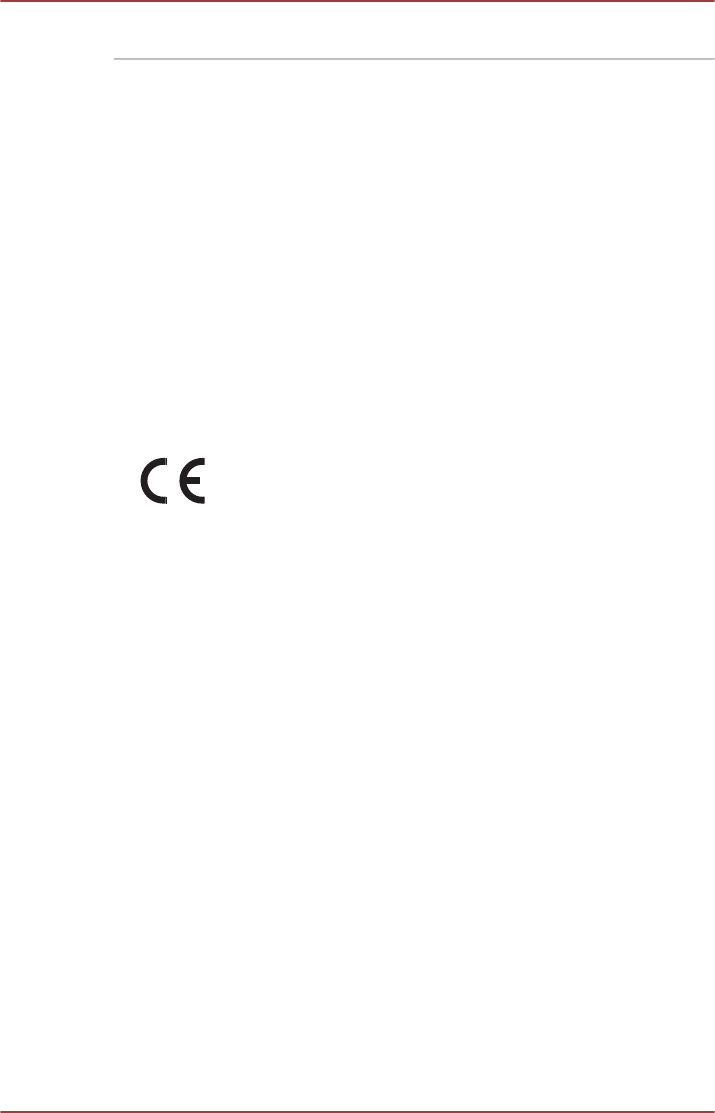
Telephone: (949) 583-3000
Caution: Exposure to Radio Frequency Radiation.
The radiated output power of the Wireless LAN is far below the FCC radio
frequency exposure limits. Nevertheless, the Wireless LAN shall be used in
such a manner that the potential for human contact during normal
operation is minimized.
In the usual operating configuration, the distance between the antenna and
the user should not be less than 20 cm. Refer to the "Grand Tour" section
in this manual for the details regarding antenna location.
The installer of this radio equipment must ensure that the antenna is
located or pointed such that it does not emit RF field in excess of Health
Canada limits for the general population; consult Safety Code 6, obtainable
from Health Canada’s website.
CE compliance
This product is carrying the CE-Mark in compliance with
the related European Directives. Responsible for CE-
Marking is TOSHIBA EUROPE GMBH, Hammfelddamm 8,
41460 Neuss, Germany. The complete and official EU
Declaration of Conformity can be found on TOSHIBA’s
web site http://epps.toshiba-teg.com on the Internet.
Working environment
The Electromagnetic Compliance (EMC) of this product has been verified
typically for this product category for a so called Residential, Commercial &
Light Industry Environment. Any other working environment has not been
verified by Toshiba and the use of this product in these working
environments is maybe restricted or cannot be recommended. Possible
consequences of the use of this product in non verified working
environments can be: Disturbances of other products or of this product in
the nearby surrounding area with temporarily malfunction or data loss/
corruption as result. Example of non verified working environments and
related advices:
Industrial environment (e.g. where 3-phase 380V mains is being used
mainly): Danger of disturbances of this product due to possible strong
electromagnetic fields especially near to big machinery or power units.
Medical environment: The compliance to the Medical Product Directive has
not been verified by Toshiba, therefore this product cannot be used as a
medical product without further verification. The use in usual office
environments e.g. in hospitals should be no problem if there is no
restriction by the responsible administration.
User's Manual 1-4

Automotive environment: Please search the owner instructions of the
related vehicle for advices regarding the use of this product (category).
Aviation environment: Please follow the instructions of the flight personnel
regarding restrictions of use.
Additional environments not related to EMC
Outdoor use: As a typical home/office equipment this product has no
special resistance against ingress of moisture and is not strong shock
proofed.
Explosive atmosphere: The use of this product in such special working
environment (Ex) is not allowed.
REACH - Compliance Statement
The new European Union (EU) chemical regulation, REACH (Registration,
Evaluation, Authorization and Restriction of Chemicals), entered into force
on 1 June 2007. Toshiba will meet all REACH requirements and is
committed to provide our customers with information about the chemical
substances in our products according to REACH regulation.
Please consult the following website www.toshiba-europe.com/computers/
info/reach for information about the presence in our articles of substances
included on the candidate list according to article 59(1) of Regulation (EC)
No 1907/2006 („REACH“) in a concentration above 0.1% weight by weight.
Following information is only valid for EU-
member States:
Disposal of products
The crossed out wheeled dust bin symbol indicates that
products must be collected and disposed of separately
from household waste. Integrated batteries and
accumulators can be disposed of with the product. They
will be separated at the recycling centres.
The black bar indicates that the product was placed on the
market after August 13, 2005.
By participating in separate collection of products and
batteries, you will help to assure the proper disposal of
products and batteries and thus help to prevent potential
negative consequences for the environment and human
health.
For more detailed information about the collection and
recycling programmes available in your country, please
visit our website (http://eu.computers.toshiba-europe.com)
or contact your local city office or the shop where you
purchased the product.
User's Manual 1-5
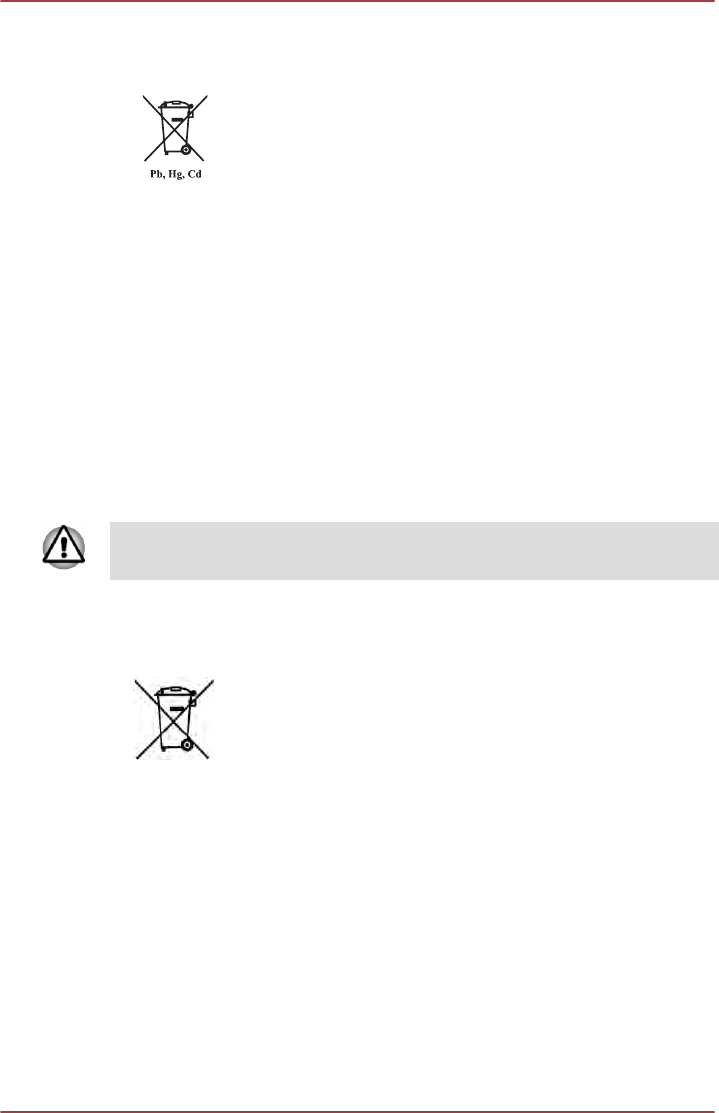
Disposal of batteries and/or accumulators
The crossed out wheeled dust bin symbol indicates that
batteries and/or accumulators must be collected and
disposed of separately from household waste.
If the battery or accumulator contains more than the
specified values of lead (Pb), mercury (Hg), and/or
cadmium (Cd) defined in the Battery Directive (2006/66/
EC), then the chemical symbols for lead (Pb), mercury
(Hg) and/or cadmium (Cd) will appear below the crossed
out wheeled dust bin symbol.
By participating in separate collection of batteries, you will
help to assure the proper disposal of products and
batteries and thus help to prevent potential negative
consequences for the environment and human health.
For more detailed information about the collection and
recycling programmes available in your country, please
visit our website (http://eu.computers.toshiba-europe.com)
or contact your local city office or the shop where you
purchased the product.
These symbols may not stick depending on the country and region where
you purchased.
Following information is only for India
The use of this symbol indicates that this product may not
be treated as household waste.
By ensuring this product is disposed of correctly, you will
help prevent potential negative consequences for the
environment and human health, which could otherwise be
caused by inappropriate waste handling of this product.
For more detailed information about recycling of this
product, please visit our website (http://www.toshiba-
india.com) or contact call center (1800-200-8674).
Canadian regulatory information (Canada only)
This digital apparatus does not exceed the Class B limits for radio noise
emissions from digital apparatus as set out in the Radio Interference
Regulation of the Canadian Department of Communications.
Note that Canadian Department of Communications (DOC) regulations
provide, that changes or modifications not expressly approved by
TOSHIBA Corporation could void your authority to operate this equipment.
User's Manual 1-6

This Class B digital apparatus meets all requirements of the Canadian
Interference-Causing Equipment Regulations.
Cet appareil numérique de la class B respecte toutes les exgences du
Règlement sur le matériel brouileur du Canada.
Canada - Industry Canada (IC)
This device complies with RSS 210 of Industry Canada.
Operation is subject to the following two conditions: (1) this device may not
cause interference, and (2) this device must accept any interference,
including interference that may cause undesired operation of this device.
The term "IC" before the equipment certification number only signifies that
the Industry Canada technical specifications were met.
Following information is only for Turkey:
Compliant with EEE Regulations: Toshiba meets all requirements of
Turkish regulation 26891 “Restriction of the use of certain hazardous
substances in electrical and electronic equipment”.
The number of possible pixel failures of your display is defined
according to ISO 9241-307 standards. If the number of pixel failures is
less than this standard, they will not be counted as defect or failure.
Battery is a consumption product, since the battery time depends on
the usage of your tablet. If the battery can not be charged at all, then it
is a defect or failure. The changes in battery time is not a defect or
failure.
User's Manual 1-7
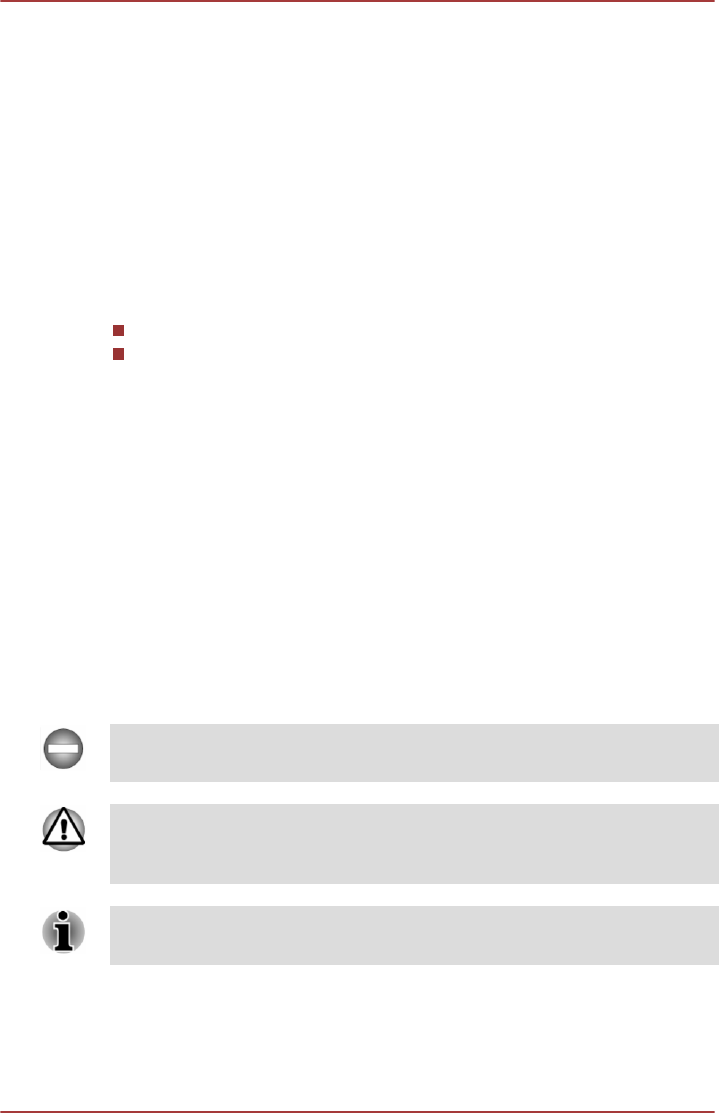
Chapter 2
Introduction
Welcome and thank you for choosing a TOSHIBA product.
About the guide
For your convenience, your TOSHIBA product is furnished with two guides:
a Quick Start Guide, and
this comprehensive PDF User’s Manual
We recommend making a backup of this User's Manual in case of future
reference.
Please backup your personal data saved in the internal storage before
updating the platform.
Instruction Manual for Safety and Comfort
All important information on the safe and proper use of this tablet is
described in the enclosed Instruction Manual for Safety and Comfort. Be
sure to read it before using the tablet.
Safety icons
Safety icons are used in this manual to bring important information to your
attention. Each type of icon and its implication are identified as shown
below.
Indicates a potentially hazardous situation, which could result in death or
serious injury, if you do not follow instructions.
Pay attention! A caution informs you that improper use of equipment or
failure to follow instructions may cause data loss or damage your
equipment.
Please read. A note is a hint or advice that helps you make best use of
your equipment.
User's Manual 2-1
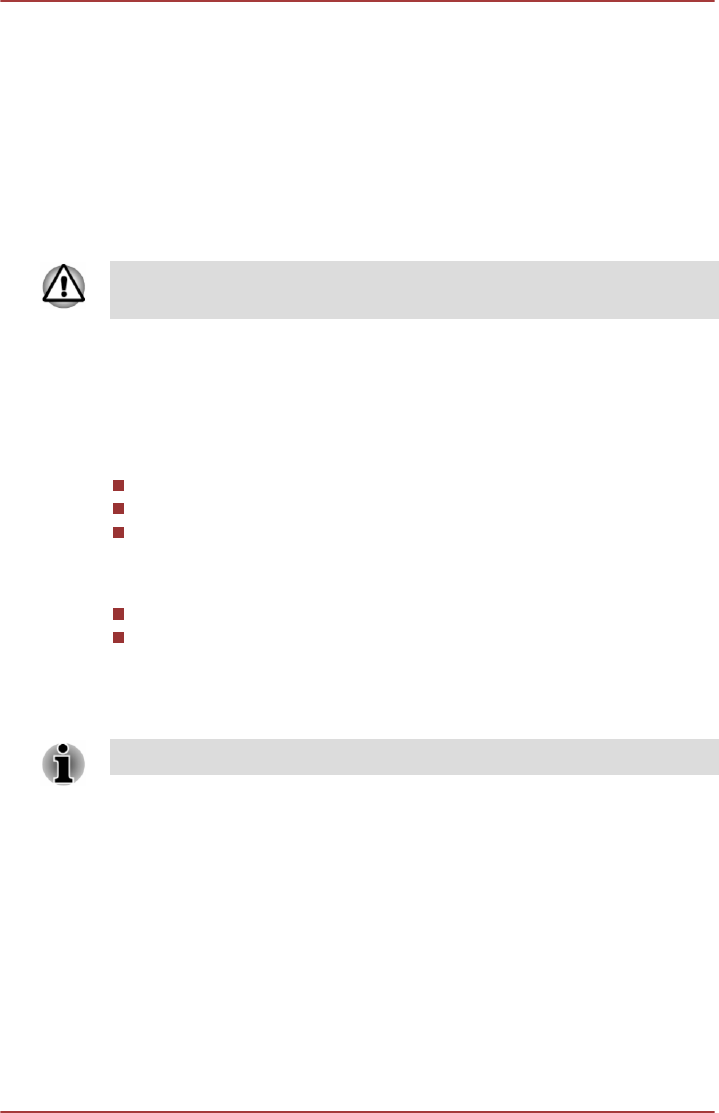
Chapter 3
Getting Started
This chapter provides a general overview of your tablet and some basics
before using your tablet.
If you use an operating system that was not pre-installed by TOSHIBA,
some of the features described in this manual might not function properly.
Check the components
Check to make sure that you have all of the following items:
Hardware
TOSHIBA Tablet
AC adaptor (equipped with some models)
Micro-USB cable
Documentation
Quick Start Guide
Instruction Manual for Safety and Comfort
If any of the items is missing or damaged, contact your dealer immediately.
Grand tour
Handle your product carefully to avoid scratching or damaging the surface.
The following figure shows each important part of your tablet.
User's Manual 3-1
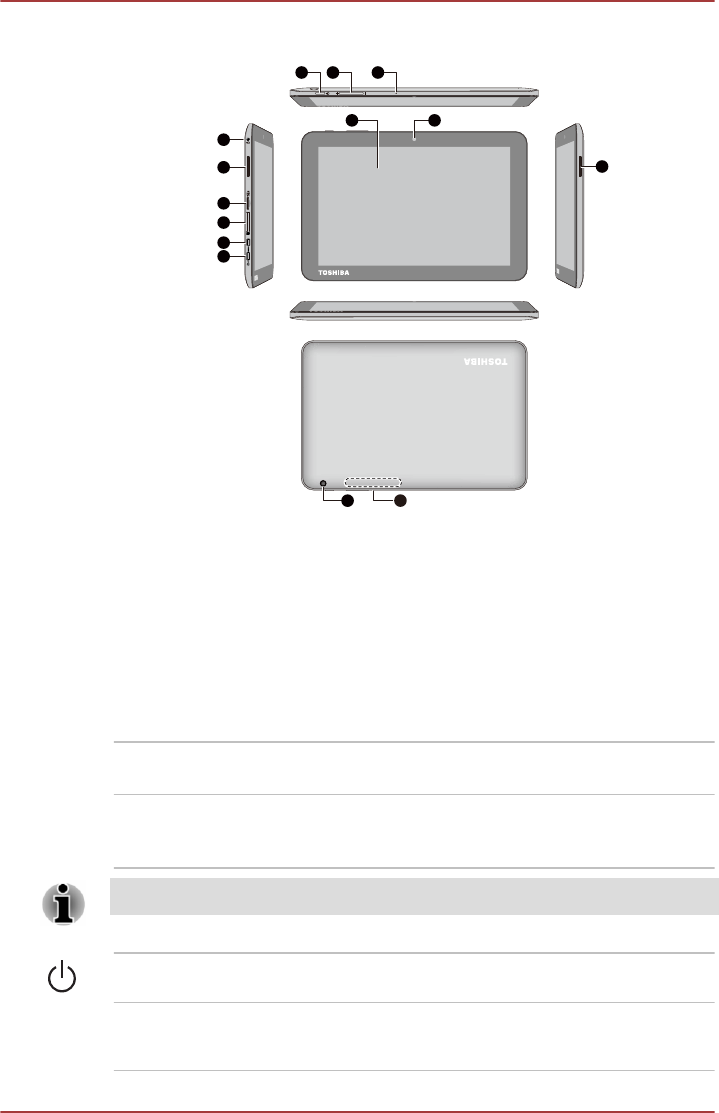
Figure 3-1 Grand tour of the tablet
7
6
7
8
9
11
10
3 54
1 2
12 13
1. Display screen 2. Web Camera (front)
3. Power button 4. Volume down/up button
5. Microphone 6. Headphone/Microphone combo jack
7. Speakers 8. Memory media slot
9. SIM card slot * 10. Micro-HDMI port
11. Micro-USB port 12. Web Camera (back)
13. Wireless communication antennas
(not shown)
* Provided with some models.
Product appearance depends on the model you purchased.
Display screen Display screen brightness can be adjusted
manually.
Camera Your tablet is equipped with a front Web Camera
and a back camera used for recording video or
taking photographs.
Both cameras might have different resolutions.
Power button Press & hold this button to turn on/off the tablet.
Volume down/up
button
Press either of the buttons to decrease or
increase the volume.
User's Manual 3-2
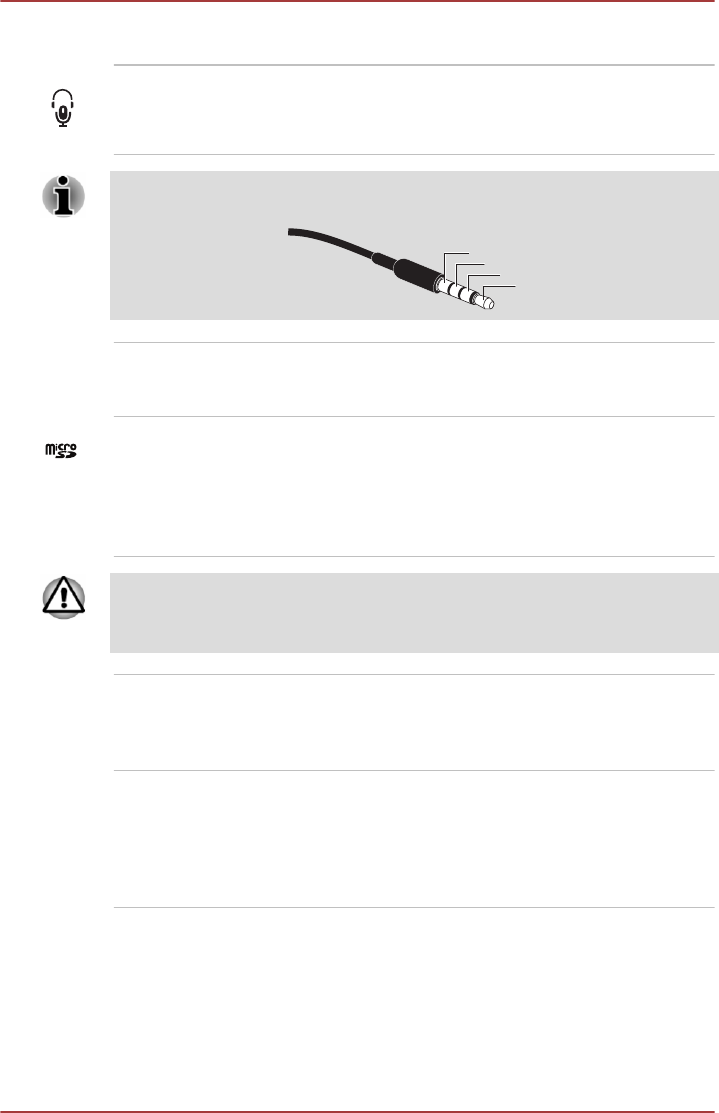
Microphone Built-in microphone allows you to record sounds.
Headphone/
Microphone combo
jack
A 3.5 mm mini headphone/microphone combo
jack enables connection of a monaural
microphone or stereo headphone.
The external microphone will be disabled if you use a 4-pin headset other
than the type as shown below.
MicGround
Right
Left
Speakers The speakers emit sound generated by your
software as well as audio alarms, such as low
battery condition, generated by the system.
Memory media slot This slot lets you insert a micro SD™ Card which
enables you to transfer data from devices, such
as digital camera, onto your tablet.
Refer to the Memory media slot section in
"Optional Accessories" chapter for details.
Keep foreign metal objects, such as screws, staples and paper clips, out of
the memory media slot. Foreign metal objects can create a short circuit,
which can cause damage and fire, possibly resulting in serious injury.
SIM card slot This slot lets you insert a single SIM card which
enables a high-speed access to the Internet,
corporate Intranet and your email while you are
away from office.
Micro-HDMI port Micro-HDMI port can connect to HDMI cable with
Type D connector.
An HDMI cable sends video and audio signals.
Refer to the HDMI device section in "Optional
Accessories" chapter for details.
User's Manual 3-3
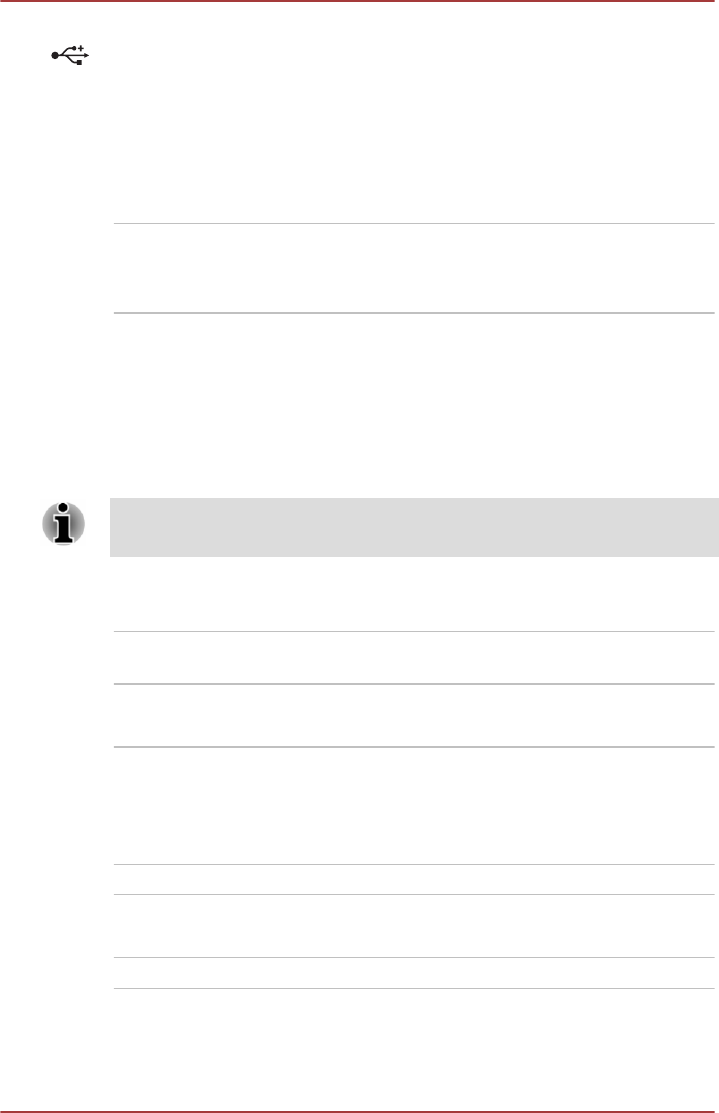
Micro-USB port The tablet acts both as a host and a client via this
port. It allows you to connect the tablet to a
computer for transferring data. When acting as a
host, the tablet can fast and directly
communicate with other client devices without
the assistance of a computer.
Please refer to the USB device section in
"Optional Accessories" chapter for details.
Wireless
communication
antennas
The tablet is equipped with Wireless LAN,
Bluetooth, and 3G antennas.
Hardware
This section identifies various components and the hardware of the tablet -
it is recommended that you become familiar with each before you operate
the tablet.
The actual specifications might vary depending on the model you
purchased.
Content that is copyright protected or has limited access rights, cannot be
played on this tablet.
Processor
CPU Your tablet is equipped with Intel Atom Z3735F
Mobile Processor.
Memory
Memory on board This tablet is equipped with a 2GB memory on
board. The actual amount of usable system
memory will be less than the installed memory
modules. This tablet does not support memory
expansion.
Flash Memory This tablet is equipped with a flash memory.
Power
Battery The tablet is powered by one lithium-ion battery.
User's Manual 3-4
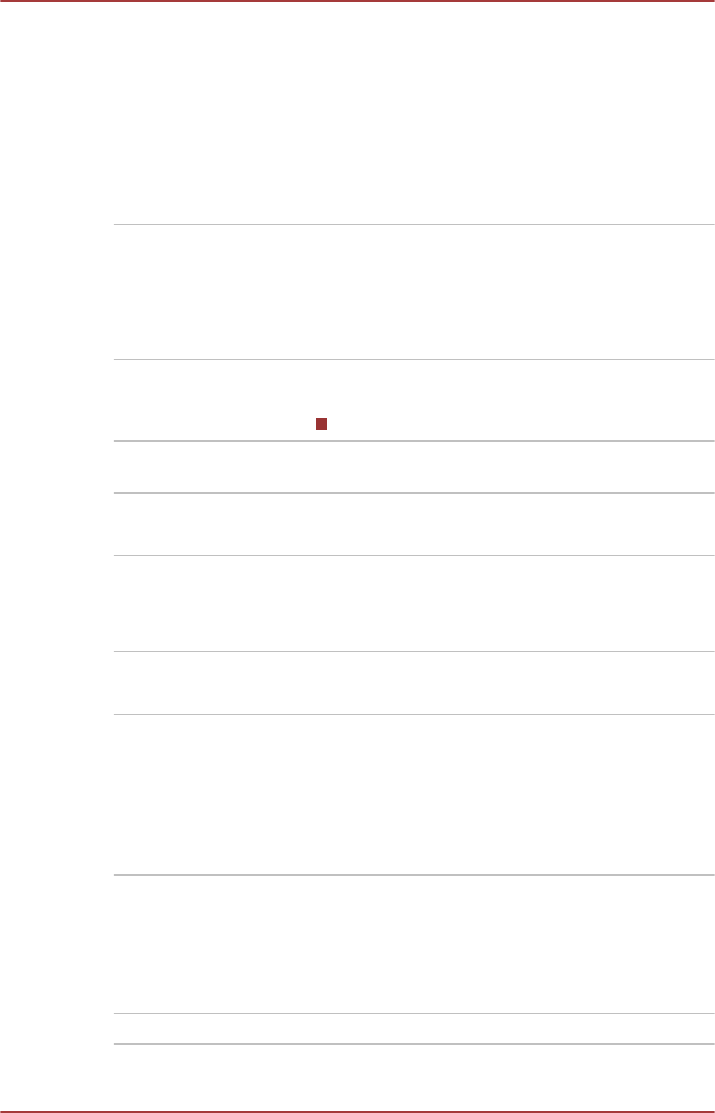
AC adaptor The AC adaptor provides power to the system
and charges the battery when it is low.
As the AC adaptor is universal, it can receive a
range of AC voltages from 100 volts to 240 volts,
however you should note that the output current
varies among different models. Using the wrong
adaptor might damage your tablet.
Some models are equipped with AC adaptor.
Display
The tablet's internal display panel supports high-resolution video graphics
and can be set to a wide range of viewing angles for maximum comfort and
readability.
Display panel 25.6. cm (10.1") LCD screen configured with the
following resolution:
1920 horizontal x 1200 vertical pixels
Graphics controller The graphics controller maximizes display
performance.
Multimedia
Web Camera Web Camera is a device that allows you to
record video or take photographs with your
tablet. You can use it for video chatting or video
conferences by using a communication tool.
Communications
Bluetooth Bluetooth wireless communication function
eliminates the need for cables between electronic
devices such as computers, printers, and mobile
phones. When it is enabled, Bluetooth will
provide the wireless personal area network
environment which is safe and trustworthy, that is
quick and easy.
Wireless LAN The tablet is equipped with a Wireless LAN/
Bluetooth combo module that is compatible with
other Wireless LAN systems based on Direct
Sequence Spread Spectrum/Orthogonal
Frequency Division Multiplexing radio technology
that complies with the IEEE 802.11 Standard.
3G Some models are equipped with a 3G module.
User's Manual 3-5
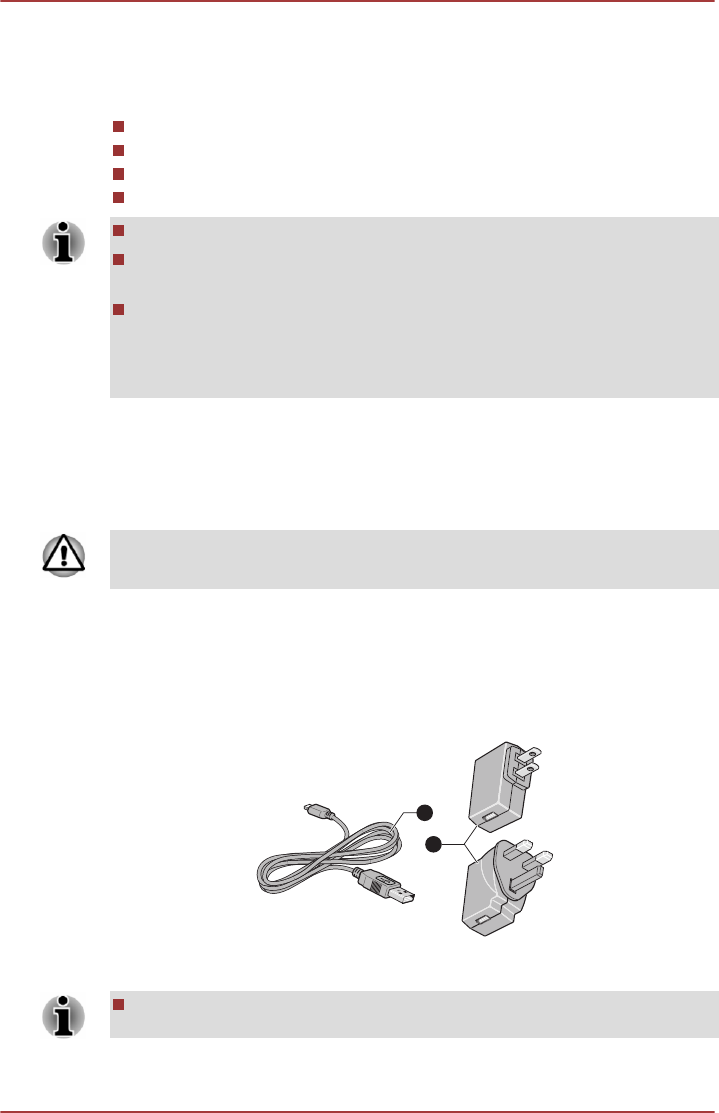
Using the tablet for the first time
This section provides basic information about how to start using your tablet.
It covers below steps followed by the details.
Connecting the AC adaptor
Turning on the power
Initial Setup
Turning off the power
Use a virus-check program and make sure that it is updated regularly.
Never format storage media without checking its content - formatting
destroys all stored data.
It is a good idea to periodically backup internal storage of the tablet to
an external media. General storage media is not durable or stable
over long periods of time and under certain conditions might result in
data loss.
Connecting the AC adaptor
Some models are equipped with AC adaptor.
When battery power becomes low, you must charge it.
Use only the tablet connected to an AC power source to charge the battery.
Never attempt to charge the battery with any other charger.
The AC adaptor can automatically adjust to any voltage ranging from 100
volt to 240 volt and to a frequency of either 50 hertz or 60 hertz, enabling
you to use this product in almost any country/region. The adaptor converts
AC power to DC power and reduces the voltage supplied to this tablet.
Figure 3-2 AC adaptor & Micro-USB cable
1
2
2-pin
3-pin
1. AC adaptor 2. Micro-USB cable
Depending on the model, either a 2-pin or 3-pin AC adaptor might be
bundled with the tablet.
User's Manual 3-6
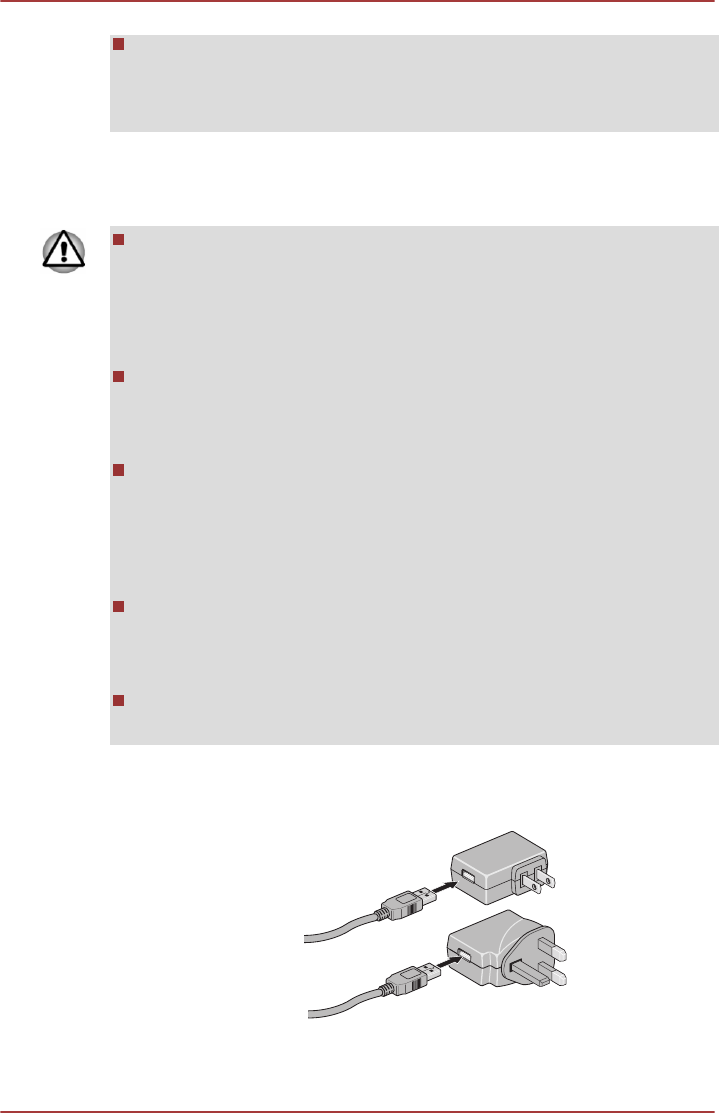
The supplied Micro-USB cable conforms to safety rules and is
designed to provide adequate and steady power supply to the tablet.
Make sure to use the supplied Micro-USB cable when you charge the
tablet or purchase an optional USB cable from TOSHIBA website.
Attach the AC adaptor when you want to charge the battery or operate from
AC power. It is also the fastest way to get started, because the battery
must be charged before you can operate from battery power.
Always use the TOSHIBA AC adaptor that was included with your
tablet, or use AC adaptors specified by TOSHIBA to avoid any risk
damage to the tablet. Use of an incompatible AC adaptor could cause
fire or damage to the tablet possibly resulting in serious injury.
TOSHIBA assumes no liability for any damage caused by use of an
incompatible adaptor.
Never plug the AC adaptor into a power source that does not
correspond to both the voltage and the frequency specified on the
regulatory label of the unit. Failure to do so could result in a fire or
electric shock, possibly resulting in serious injury.
When you connect the AC adaptor to the tablet, always follow the
steps in the exact order as described below. Connecting the plug to a
live electrical outlet should be the last step otherwise the USB
connector could hold an electrical charge and cause an electrical
shock or minor bodily injury when touched. As a general safety
precaution, avoid touching any metal parts.
Never place your tablet or AC adaptor on a wooden surface, furniture,
or any other surface that could be marred by exposure to heat since
the tablet base and the surface of the AC adaptor increase in
temperature during normal use.
Always place your tablet or AC adaptor on a flat and hard surface that
is resistant to heat damage.
1. Plug the USB connector of the Micro-USB cable into the AC adaptor.
Figure 3-3 Connecting the AC adaptor 1
2-pin
3-pin
User's Manual 3-7
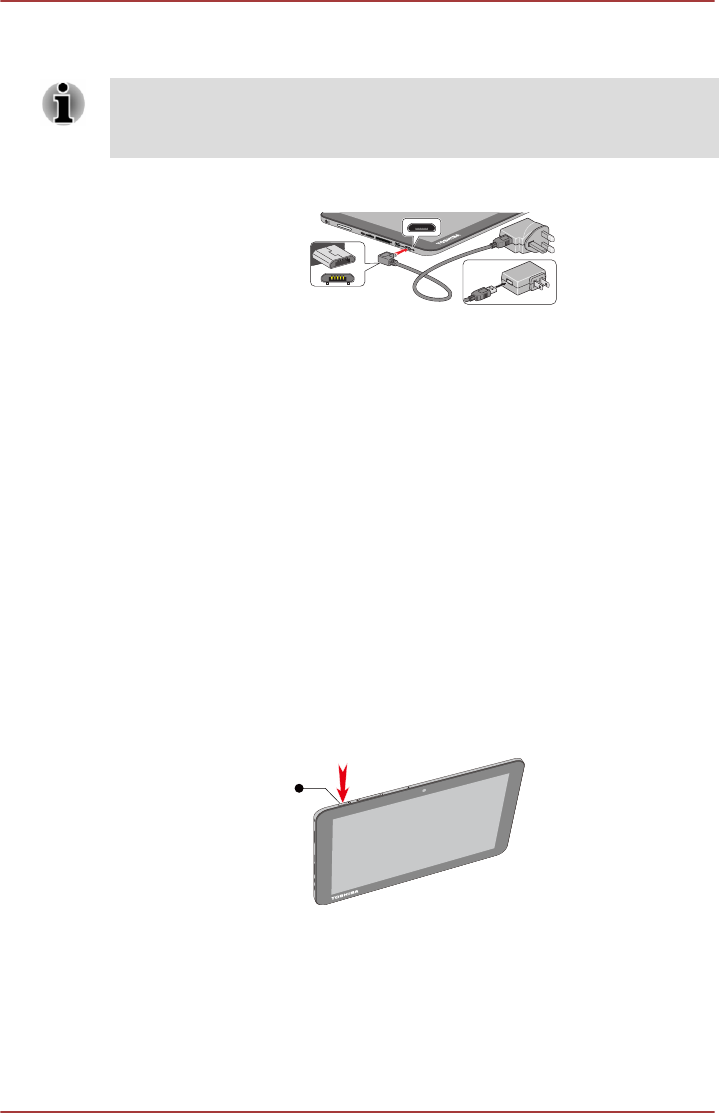
2. Plug the other smaller connector of the Micro-USB cable into the
Micro-USB port on your tablet.
The Micro-USB connector of the Micro-USB cable must be correctly
plugged into the Micro-USB port on the tablet. Failure to do so correctly
might result in possible damage to the Micro-USB port.
Figure 3-4 Connecting the AC adaptor 2
2-pin
3-pin
3. Plug the AC adaptor into a live wall outlet.
Wall outlet
The fastest way to charge your tablet is with the included AC adaptor
plugged into a wall outlet.
USB charge
In “suspend or shutdown mode,” you can also charge your tablet,
although more slowly, by connecting the Micro-USB cable to the USB
port on your PC. Make sure your PC is turned ON while charging via
USB. If your PC is turned OFF, depending on PC specifications, the
tablet battery may discharge. We recommend that you do not use your
tablet while charging via USB as auto shutdown may occur if the
battery charge is too low.
Turning on the power
This section describes how to power up your tablet.
Press & hold Power button for two seconds to turn on the tablet.
Figure 3-5 Turning on the tablet
1
1. Power button
Initial Setup
The Setup Screen will be the first screen displayed when you turn on the
power. Setup your tablet according to the following steps:
User's Manual 3-8
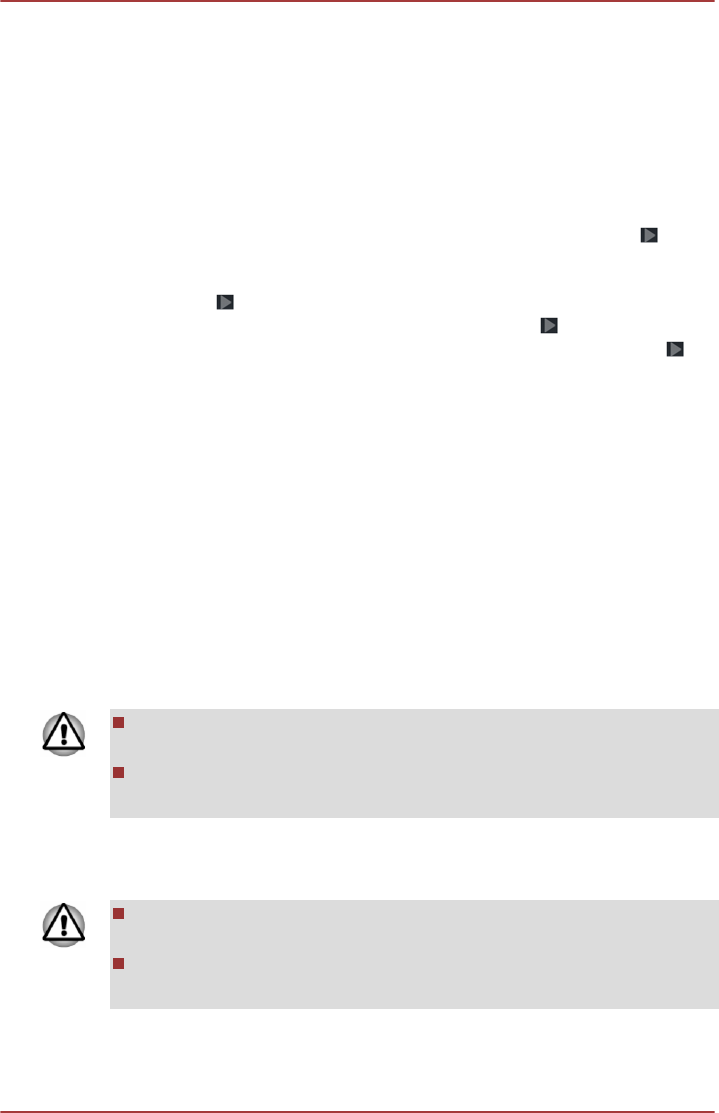
1. Choose your preferred system language and tap Start to begin with
the initial setup process.
2. Connect to a Wi-Fi network.
You can tap Skip and turn Wi-Fi on later in Settings app.
3. Sign in with a Google™ account.
If you don’t have one, tap No.
4. Register for a Google account by tapping Get an account.
You can also skip this step by tapping Not now.
5. Choose whether to use Google Location Service™ and tap to
continue.
6. If the tablet is not connected to a Wi-Fi network, set the date and time
and tap to continue.
7. Enter your name to personalize some apps. Tap to continue.
8. Tap Learn more to read the privacy policy and other terms. Tap to
agree.
9. Tap Finish to exit Setup Screen.
10. Read the Toshiba legal information. Tap Agree. Your tablet is now set
up and ready to use.
Turning off the power
If you are not going to use your tablet for a long time, shut it down. You can
also turn the LCD off in order to extend battery life.
Shut down the tablet
When you shut down the tablet, no data will be saved. The tablet will boot
to the operating system's main screen the next time it is turned on.
1. If you have entered data, either save it to flash memory or to other
storage media.
Never turn off the power while an application is running. Failure to do
so can cause data loss.
Never turn off / disconnect the power , or remove external storage
media during data read/write. Failure to do so can cause data loss.
2. Turn off or remove any peripheral devices connected to the tablet.
3. Press & hold Power button for two seconds and select Power off and
then OK to turn off the tablet.
In any emergency case, you can also press & hold Power button for
about 6 seconds to force power off.
Do not turn the tablet back on immediately. Wait a short period to
avoid any potential damage.
User's Manual 3-9
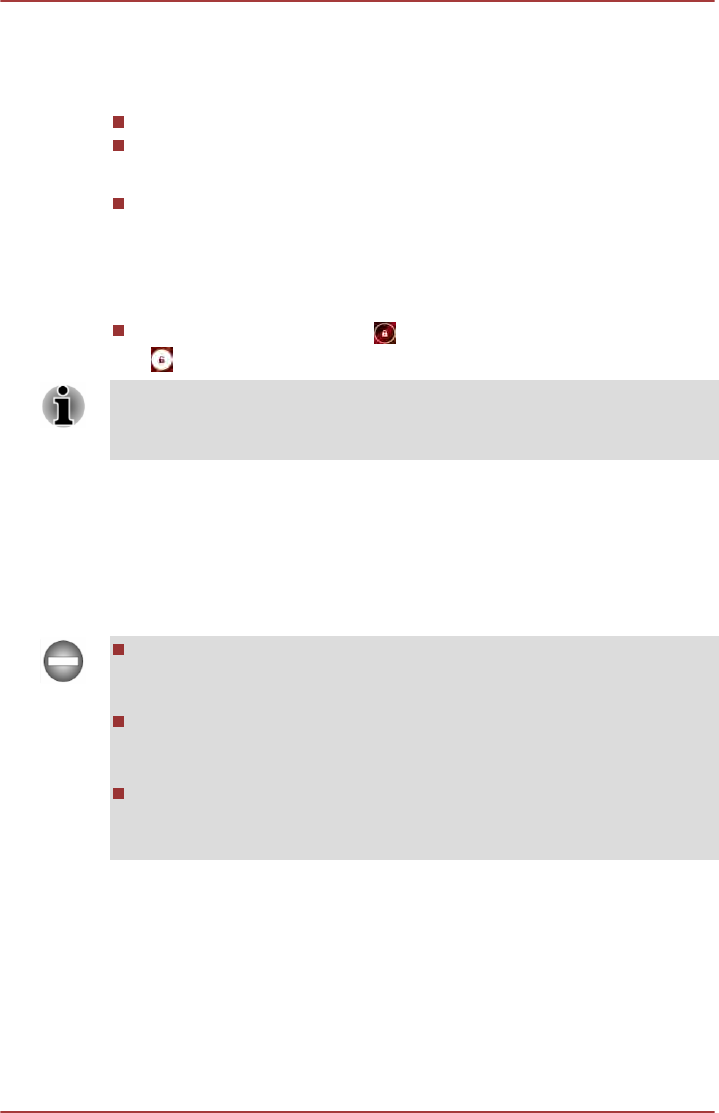
Turning the LCD off/on
You can turn the LCD off (while the system is still running) in one of the
following ways:
To turn it off manually: Press Power button.
To turn it off automatically: Set the sleep timeout in Settings app.
To turn the LCD on:
Press Power button once again.
Unlocking your screen
After turning on the LCD, the screen remains locked. You can unlock the
screen in the following way:
Press & hold the lock icon ( ) and slide it across the unlock icon (
).
If you have set up a screen lock other than Slide, the method of unlocking
the screen will be different. See Security section for other ways to protect
your tablet and privacy.
Care and use of the battery
This section provides the important safety precautions in order to handle
your battery properly.
Refer to the enclosed Instruction Manual for Safety and Comfort for
detailed precautions and handling instructions.
The lithium ion battery can explode if not handled or disposed of
properly. Dispose of the battery as required by local ordinances or
regulations.
Charge the battery only in an ambient temperature from 5 through 35
degrees Celsius. Otherwise, the electrolyte solution might leak, battery
performance might deteriorate and the battery life might be shortened.
Never try to remove or replace the battery by yourself which might
possibly result in serious injury. Contact an authorized Toshiba service
provider, if necessary.
Charging the battery
When the battery power becomes low, you must charge it to avoid losing
any data.
Procedure
You can charge the battery when the tablet is either on or off by connecting
the AC adaptor.
User's Manual 3-10

Off
An icon shaped like an actual battery appears in the center of the
screen allowing you to keep track of the battery level. When the
battery is fully charged, the meter reaches its full capacity.
On
Likewise, a battery meter on the right side of the System Bar indicates
the battery level.
Battery charging time
The following table shows the approximate time required to fully charge a
discharged battery when the AC adaptor is connected to the tablet.
Battery type Charging time
Battery (1 cell, 19.5 Wh) about 5 hours
Please be aware that the charging time when the tablet is on is affected by
ambient temperature, the temperature of the tablet and how you are using
the tablet - for example if you make heavy use of external devices then the
battery might get scarcely charged up.
Battery exhausted time
The following table shows the approximate exhausted time of a fully
charged battery.
Battery type Time
Battery (1 cell, 19.5 Wh) about 6.5 hours (in use)
about 150 hours (sleep mode)
Please be aware that the battery exhausted time will be affected by how
you are using the tablet.
Battery charging notice
The battery may not begin charging immediately under the following
conditions:
The battery is extremely hot or cold (if the battery is extremely hot, it
might not charge at all). To ensure the battery charges to its full
capacity, you should charge it at room temperature of from 5°C
through 35°C (41°F - 95°F).
User's Manual 3-11

The battery is nearly completely discharged. In this instance, the tablet
cannot be turned on immediately. You should leave the AC adaptor
connected for a few minutes and the battery should begin charging. A
battery meter icon ( ) will appear indicating the charging status.
The indicator may show a rapid decrease in battery operating time when
you try to charge a battery under the following conditions:
The battery has not been used for a long time.
The battery has completely discharged and been left unattended for a
long time.
In such cases you should follow the steps as detailed below:
1. Fully discharge the battery when powered on until the system
automatically turns the tablet off.
2. Connect the AC adaptor to the Micro-USB port on the tablet, and to a
wall outlet that is supplying power.
3. Charge the battery until the battery meter reaches its full capacity.
Repeat these steps two or three times until the battery recovers normal
capacity.
User's Manual 3-12

Chapter 4
Basics
This chapter describes the basic operations of your tablet and the Home
screen.
Using the touch screen
You can use your finger to manipulate icons, buttons, menu items, the
onscreen keyboard, and other items on the touch screen.
Tap
Simply tap your finger on the touch screen to act on items on the
screen, such as application and settings icons, to type letters and
symbols using the onscreen keyboard, or to tap onscreen buttons.
Press & hold
Press & hold an item on the screen until an action occurs.
Drag
Press & hold an item for a moment and then, without lifting your finger,
move your finger on the screen until you reach the target position. You
can drag items on the Home screen to reposition them.
Swipe or slide
To swipe or slide, you quickly move your finger across the surface of
the screen, without pausing when you first touch it (so you don’t drag
an item instead). For example, you slide the screen up or down to
scroll a list.
Double tap
Tap quickly twice on a webpage, map or other screen to zoom.
Pinch
In some apps (such as Browser and Gallery), you can zoom in/out by
placing two fingers on the screen at once and pinching them together
or spreading them apart.
Getting to know the Home screen
The Home screen is your starting point for using all the installed apps on
your tablet. You can customize the Home screen to display the widgets,
app shortcuts, wallpapers, and other shortcuts you prefer.
User's Manual 4-1
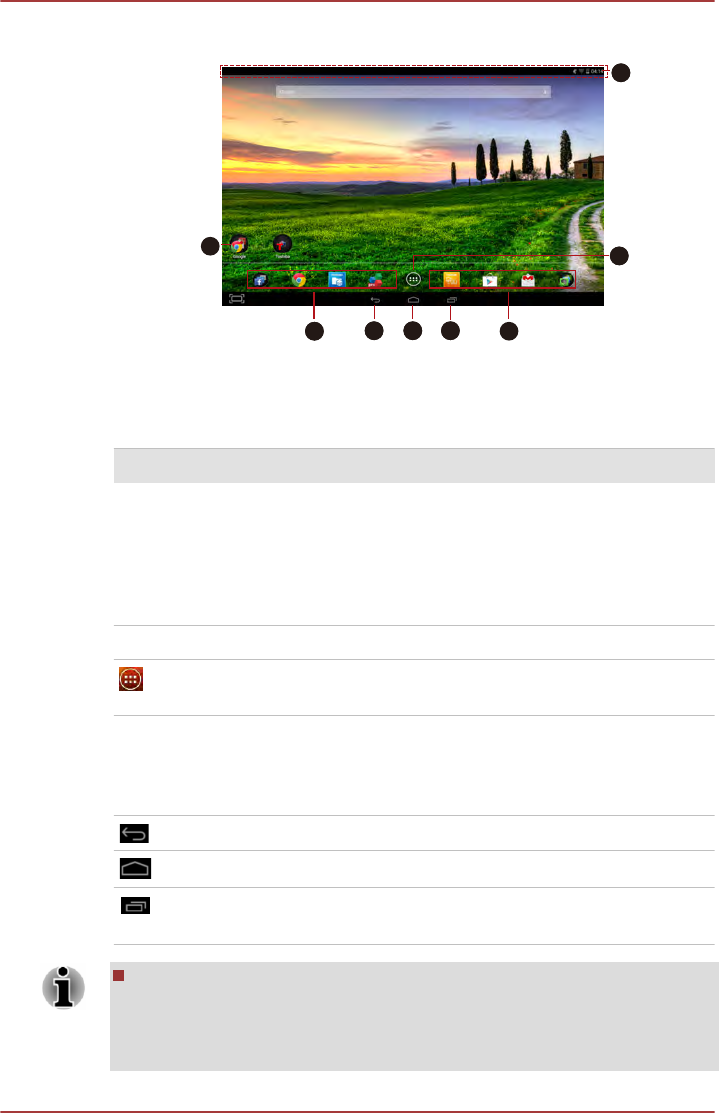
Figure 4-1 Home screen
3
1
2
5 6 7
4 4
1. System bar 2. App shortcuts
3. All Apps 4. Favorite tray
5. Back 6. Home
7. Recent apps
Item Description
System bar The System bar is located at the top
of the screen. The notifications
icons and notification panel are on
the left, and the status icons and
Quick settings panel are on the
right.
App shortcuts Tap to open an app.
All Apps Tap to see all your apps and
widgets.
Favorite tray The Favorite tray is located at both
left and right side of All Apps. You
can move your favorite apps to
Favorite tray.
Back Return to the previous screen.
Home Return to the default Home screen.
Recent apps Tap to see the thumbnails of your
recently used apps.
Some application can hide Back, Home, Recent apps icons, and
System bar.
To bring them back, tap their locations or swipe an edge from the top
or bottom of the screen.
User's Manual 4-2

Swipe left or right to see more Home screen panels.
You can place app shortcuts and widgets on Home screen. See
Customizing the Home screen section for the details.
Opening and switching applications
Opening an application
You may open an application by:
Tapping its icon on the Home screen.
Tapping its icon from the All Apps main screen.
Switch to a recently used application
You may switch to recently used application by:
Tap Recent apps ( ) and select an application that you want to
switch to.
To remove an application, swipe the thumbnail upwards or
downwards.
Monitoring your tablet’s status
Status icons
Battery level, Wi-Fi status, and other tablet's status are shown in icons on
the right side of System bar. Some status icons will not be shown if the
status information are not available.
Notification icons
The notification from system and apps are shown in icon on the left side of
System bar.
Quick Settings
You can use Quick Settings to change frequently used settings. To open
the Quick Settings panel, swipe down the right side of the system screen.
The current user is shown in Quick Settings panel. You can also find the
following settings:
Brightness
Tap to set the brightness of the display.
Settings
Tap to open Settings app.
Wi-Fi
Press & hold to turn on/off Wi-Fi. You can also tap to open Wi-Fi
option in Settings app.
User's Manual 4-3

Auto rotate
Tap to turn on/off the auto-rotate screen feature.
Battery
Tap to open Battery option in Settings app.
Airplane mode
Tap to turn on/off airplane mode. All wireless radios are disabled
when it is turned on.
Bluetooth
Press & hold to turn on/off Bluetooth. You can also tap to open
Bluetooth option in Settings app.
Location
Tap to open Location option in Settings app.
More settings could be shown in Quick Settings panel depending on your
use of the tablet, such as Alarm.
Managing Notifications
Opening the notifications panel
To open Notification panel, swipe down the left side of the system bar.
Notifications of ongoing activities are listed first, followed by notifications of
events, such as a new mail notification. You can tap the area out of the
notifications panel to close the notifications panel.
Responding to a notification
To respond to a notification, do the following:
1. Open the notifications panel.
Your current notifications are listed in the panel, each with a brief
description.
2. Tap a notification to respond to it.
The notifications panel closes. What happens next depends on the
notification.
Dismissing a notification
Some notifications can be dismissed by sliding it sideways.
Locking your screen
You can lock your screen so that only you can unlock it to access your
data, run applications and so on. See Security section for other ways to
protect your tablet and privacy.
User's Manual 4-4

Locking your screen with a Pattern lock
For example, you can use a Pattern lock to lock your screen with following
steps.
1. Open the security settings by tapping All Apps -> Settings ->
Security.
2. Tap Screen lock -> Pattern.
Follow the onscreen instructions to finish the creation.
The next time you turn on your tablet or wake up the screen, you will be
prompted to draw your unlock pattern to unlock the screen.
Capturing your screen
You can capture a screenshot by simultaneously pressing and holding
Power and Volume down button for about 2 seconds. The tablet shows
the preview for a few seconds and save it.
You can find and view the screenshot you've just captured from the
notification panel.
Customizing the Home screen
You can add application shortcuts or widgets to Home screens. You can
also change the wallpaper.
Adding an item to the Home screen
To add an item to the Home screens, follow the steps listed below:
1. Tap All Apps on the Home screen.
2. Tap APPS and WIDGETS tab. You can also swipe left or right to
move between screens.
3. Press & hold an item and the Home screen will appear. Drag it to the
place you want.
You might need to do some configurations when operating a widget.
You can resize some widgets on the Home screen by following below
steps:
1. Press & hold the widget until it moves upwards and a resize handle
will appear on each side.
2. Drag the resize handle to resize the widget.
The number of widgets you can add depends on the size of each widget. If
there is not enough room, the widget cannot be added.
Moving an item on the Home screen
To move an item on the Home screen, do the following:
User's Manual 4-5

1. Press & hold the item you want to move until its icon is magnified.
Don’t lift your finger from the screen.
2. Drag the item to a new location on the screen.
It will pause at the left or right edge of the screen to drag the item onto
extended Home screen.
3. When the item is at expected place, lift your finger.
Removing an item from the Home screen
To remove an item from the Home screen, do the following:
1. Press & hold the item you want to remove until its icon moves upward.
× appears.
2. Drag the item to × .
3. When the item icon glows red, lift your finger.
Changing the wallpaper
Wallpaper is an image used to replace the default background of your
Home screen.
1. Press & hold anywhere on the Home screen that is not occupied.
2. Tap an option to select a wallpaper source.
3. Select a wallpaper.
4. Tap Set wallpaper.
Creating a grouped folder
Folders provide an easy way to organize and manage your apps shortcuts.
You can group several app icons into a folder.
Drag and drop an app icon on top of the other to automatically create a
grouped folder. To rename the created folder, tap to open it and tap its
name at the bottom to enter a new one.
Press & hold an icon in the folder and drag it to the Home screen. When
the folder has only one app icon, this folder will be automatically ungrouped
leaving the last icon on the Home screen.
Changing the Screen Orientation
You can change the screen orientation from Landscape to Portrait mode by
rotating the tablet sideways (and vice versa). The screen orientation
automatically changes according to the rotation angle detected.
You can disable the auto rotation in Quick Settings and always use the
tablet in Portrait or Landscape mode.
Managing Tasks and Applications
You can manage some of the running applications by following the steps
below:
User's Manual 4-6
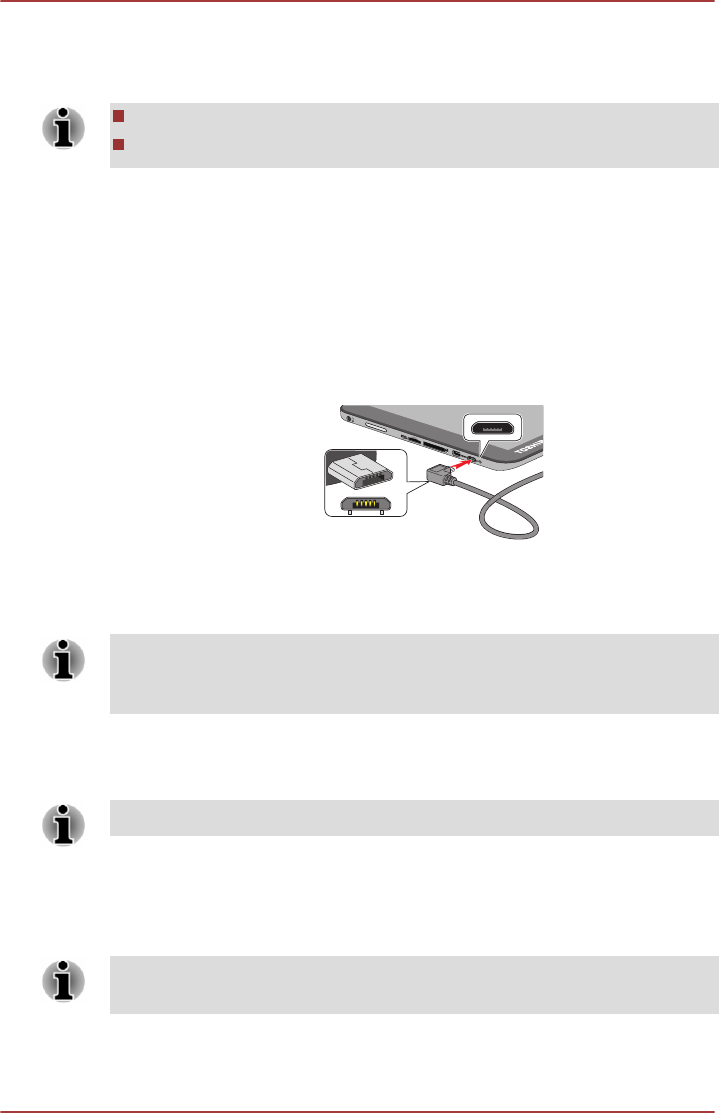
1. Tap All Apps -> Settings -> Apps.
2. Tap an item you want to manage from DOWNLOADED/RUNNING/
ALL/DISABLED tab.
Refer to Apps section in Settings chapter for details.
You can stop some of the running applications.
Connecting to a computer
With a Micro-USB port on the tablet, you can connect your tablet to a
computer for data transfer.
To connect to a computer:
1. Plug the Micro-USB connector of the USB cable into the Micro-USB
port on this tablet.
Figure 4-2 Connecting an Micro-USB cable
1. Micro-USB port 2. Micro-USB connector
2. Plug the other end of the USB cable into the USB port on the
computer.
The Micro-USB connector of the USB cable must be correctly plugged into
the Micro-USB port on the tablet. Failure to do so correctly might result in
possible damage to the Micro-USB port.
Depending on your settings, your tablet will be recognized as a removable
MTP (Media Transfer Protocol) device or PTP (Picture Transfer Protocol)
device allowing you to access its contents from a computer.
If your computer does not support MTP, try using PTP instead.
To remove this tablet from a computer:
1. Make sure all file operations are finished.
2. Unplug the tablet from your computer.
Make sure the connector is properly aligned with the socket. Do not try to
force the connection, Failure to do so can damage the connecting pins.
User's Manual 4-7

Factory Reset
The tablet provides you with the function to reset it. Before executing the
reset, you need to backup the system settings, application settings, user
installed applications and data in the internal storage.
To perform the factory data reset, do the following:
1. Tap All Apps -> Settings -> Backup & reset -> Factory data reset -
> Reset tablet -> Erase everything.
2. The factory data reset will be done.
Note that the following data will be erased:
System settings and application settings
User installed applications
Internal storage files, such as music or photos
Data in the removable media will not be erased.
User's Manual 4-8

Chapter 5
Applications
This chapter describes the usage of applications & widgets.
Your tablet has some Google Mobile services™ installed and the
availability of the applications may vary depending on your country or
region. Some applications will be automatically hidden after the first power
on.
Calculator
You can use Calculator to solve simple arithmetical problems or use its
advanced operators to solve more complex equations.
Delete: tap Delete icon ( ) to delete the last number or operator
you entered.
Press & hold this icon to delete everything you entered.
copy/cut: press & hold the calculation area to select copy or cut.
Calendar
You can use Calendar to remind on dates, events or appointments.
Add events to Calendar
You can add events to Calendar by following these steps:
1. Press & hold any blank period on your calendar or tap the New
Events icon ( ) on the top right corner of Calendar screen.
2. Enter Event name and set details for this date.
3. Tap Done to save.
Camera
Camera is a combination of camera and camcorder that you can use to
take and share pictures/videos. Pictures and videos can be viewed in the
Gallery.
Open Camera and take pictures/videos
You can take pictures and shoot videos with the Camera.
To open the Camera, tap All Apps -> Camera.
User's Manual 5-1
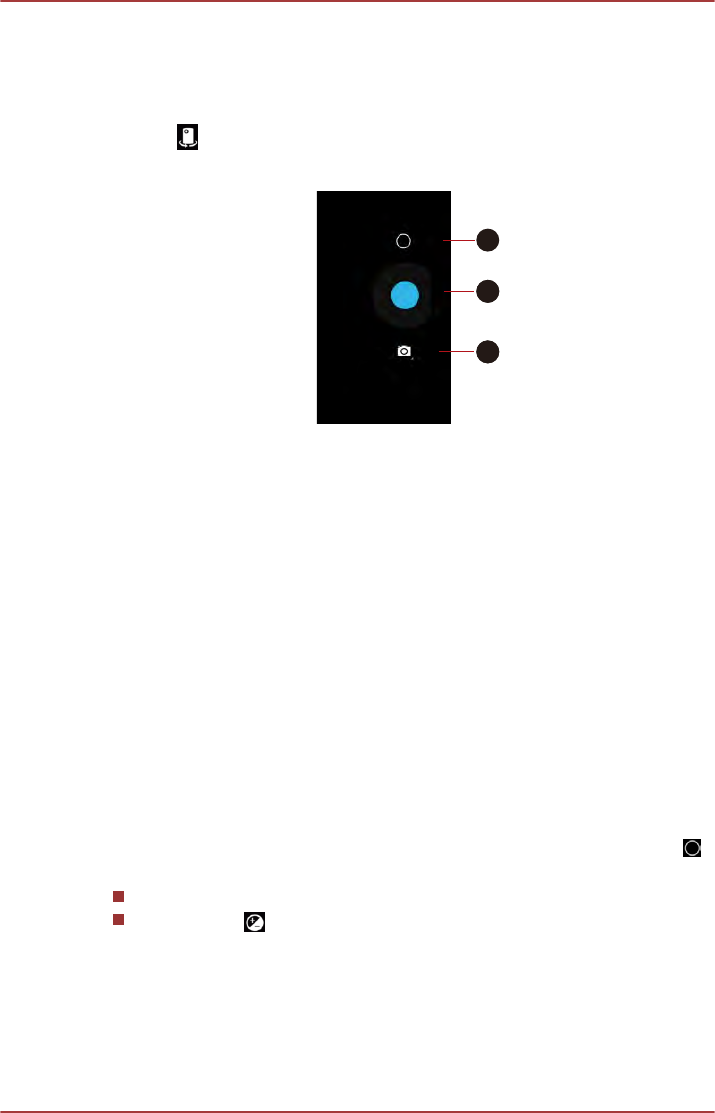
Camera will open, ready to take a still picture. You can switch Camera to
video or panorama mode anytime by tapping the proper icon in option 3 of
the following figure.
The back camera is set for default. You can switch to front camera by
tapping icon in option 1 of the following figure.
Figure 5-1 Camera screen
1
3
2
1. Photo/Video options 2. Take a photo/video
3. Choose photo, video or panorama
mode
Panorama mode
Panorama mode allows you to take multiple subsequent photos and the
tablet automatically join them together to create a single image with a wide-
angle view.
After the camera is set to panorama mode, you will select how shots will be
stitched - slowly move the camera left to right or right to left.
Review your pictures/videos
You can review the pictures/videos you’ve just taken by swiping left
Camera screen.
Photo options
Several options are available by tapping the Photo/Video options icon (
).
HDR:Tap to enable HDR function.
Exposure ( ): Choose the value to change the exposure rate.
User's Manual 5-2
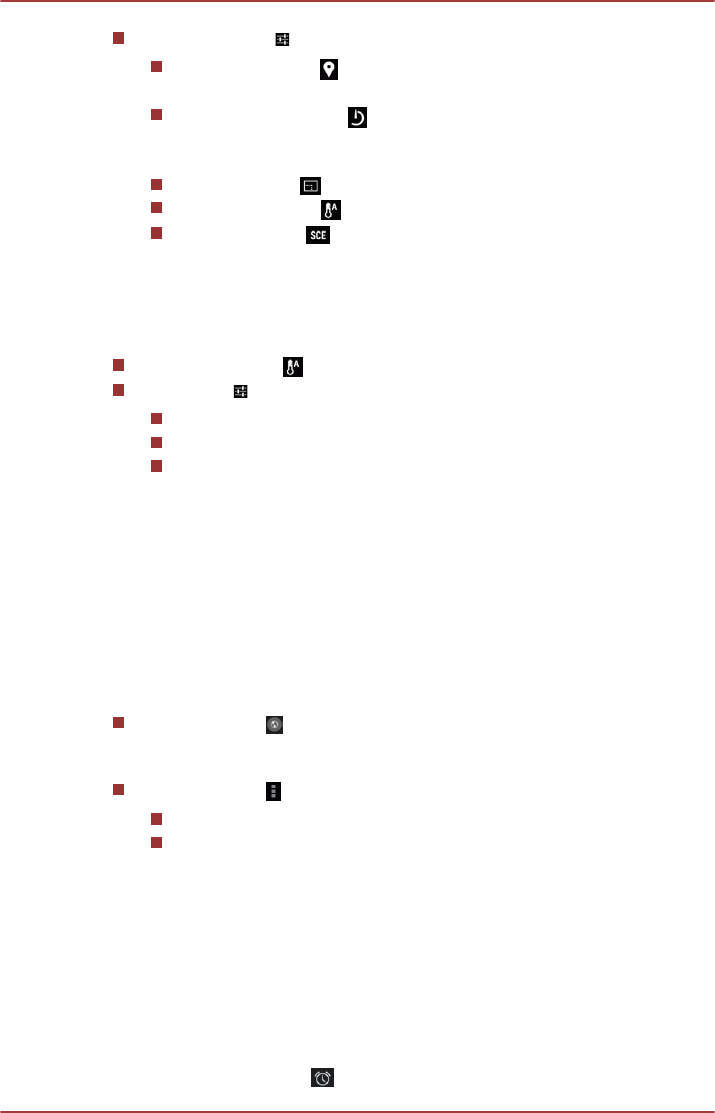
More options ( ): Tap to find the following options:
Store location ( ): Tap to enable or disable storing location
information of pictures you take.
Countdown timer ( ): Set the duration before the picture is
taken. Check Beep during countdown to allow beeps during
countdown.
Picture size ( ): Choose the size of the pictures you take.
White balance ( ): Adjust the lighting conditions.
Scene mode ( ): Choose your environment.
Video options
Similarly, in Video mode, the following options are available on video
record screen.
White balance ( ): Adjust the lighting conditions.
Settings ( ): Tap to find the following options:
Time lapse: Choose a time interval for time lapse recording.
Video quality: Tap to select the quality of the videos you take.
Store location: Tap to enable or disable storing location
information of pictures you take.
Clock
In addition to displaying the date and time, you can use Clock to set an
alarm, timer, and stopwatch.
To open Clock, tap All Apps -> Clock.
Working with Clock
You can change Clock settings as follows:
Tap the icon ( ) to display a list of cities with different time zones.
Check to show the clock of a city on Clock screen. You can select
more than one city.
Tap the icon ( ) to find more settings for Clock:
Night mode: Select to view local time with very dim display.
Settings: The following options are displayed:
Style: Tap to open a dialog where you can choose the style of
the Clock.
Automatic home clock: Check to add a clock for home when
travelling in an area with different time zone.
Home time zone: Tap to open a list of time zones. Check to
select a time zone for your home.
Setting an alarm
1. Tap the alarm icon ( ).
User's Manual 5-3
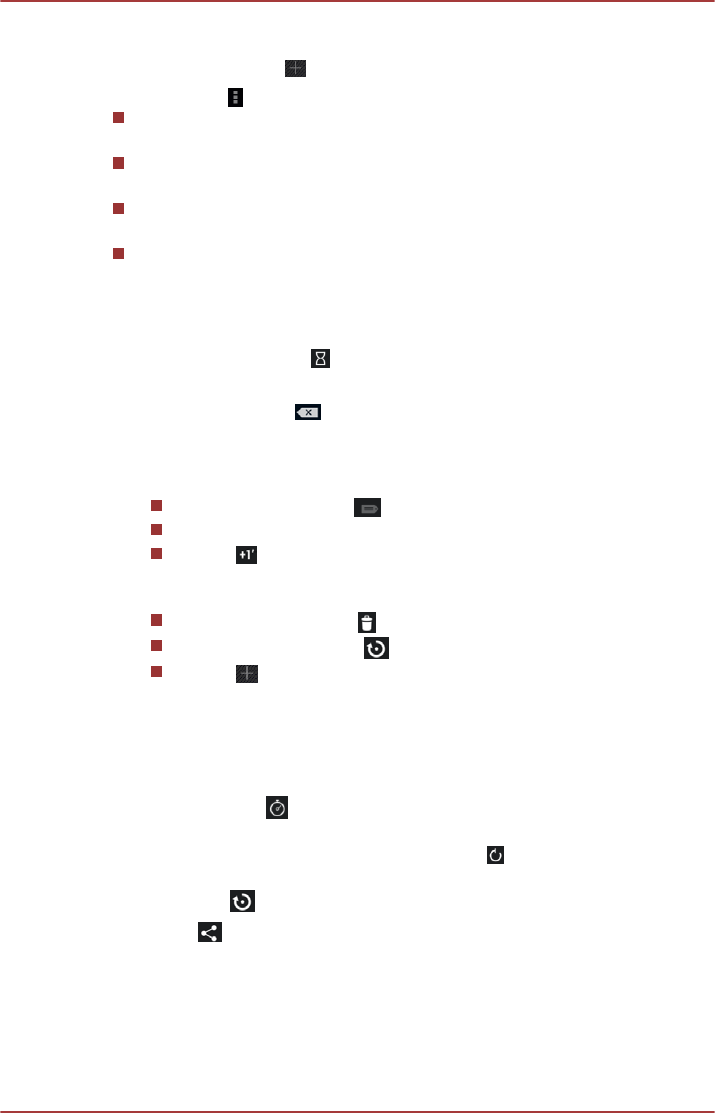
2. Tap an existing alarm clock to change its time and other settings.
Or tap the icon ( ) to add a new one.
Tap the icon ( ) to find more settings for alarms:
Silence after: Select the time when you want your alarm to stop
ringing.
Snooze length: Select how long your alarm will snooze after you
turned it off.
Alarm volume: Tap to open a dialog where you can drag a slider to
adjust the volume.
Volume buttons: Tap to open a dialog where you can choose if you
want your Volume buttons to Snooze, Dismiss, or Do nothing.
Setting a timer
1. Tap the timer icon ( ).
2. Enter the period of time you want.
Tap Delete icon ( ) to delete the last number you entered. Press &
hold this icon to delete everything in the display.
3. Tap Start.
After starting a timer, you can work with it as follows:
Enter a name: Tap ( ).
Pause a timer: Tap STOP.
Tap ( ) to add one minute to the current time. One minute can
be added with each tap. You can tap several times to add more
minutes.
Delete a timer: Tap ( ).
Repeat a timer: Tap ( ).
Tap ( ) to add more timers.
The timer beeps when the time is up. It will keep beeping until you tap
STOP.
Using the stopwatch
1. Tap the icon ( ) to open the stopwatch.
2. Tap START to start time counting. You can add more laps when the
stopwatch is running by tapping the icon ( ).
3. Tap STOP to stop. Then you can either tap START to continue or tap
the icon ( ) to open a new stopwatch.
Tap ( ) to share the results via Bluetooth, email, and more.
Downloads
You can use the Downloads application to view and manage downloaded
files.
To open the Downloads, tap All apps -> Downloads.
User's Manual 5-4
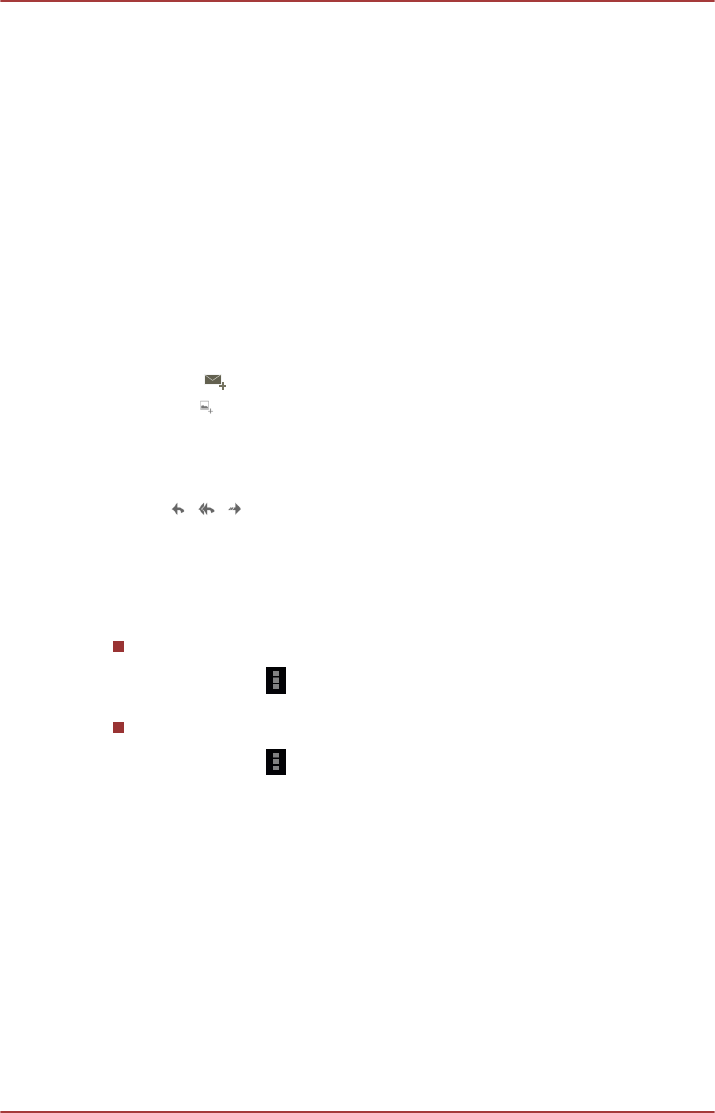
Email
You can use the Email application to read and send emails.
To open the Email, tap All Apps -> Email.
Read an email
You can read emails in the Inbox or other folders for individual accounts.
Tap the email to read. If two or more accounts are added, you can read all
received emails by tapping combined view.
Send an email
You can send an email to your contacts or to other people.
To send an email:
1. Tap ( ) and enter the recipient, subject, and message.
2. Tap ( ) to add one or more pictures.
Respond to an email
You can reply to or forward an email that you’ve received. Tap one of the
icons ( ) to execute Reply, Reply all, or Forward operations.
You can also delete email and manage them in other ways.
Manage email accounts
The Email application allows you to add and manage your email accounts.
To add an email account:
Tap the icon ( ) and select Settings. On the Settings screen, tap
ADD ACCOUNT.
To edit account settings:
Tap the icon ( ) and select Settings.
General settings applies to all accounts.
To edit settings of a specific account, tap the account name.
Gallery
You can use Gallery to view pictures and play videos that taken with the
Camera, downloaded or copied onto your tablet.
Open Gallery
To view your pictures and videos, tap All apps -> Gallery.
Gallery shows the pictures and videos on your tablet, including those
you’ve taken with Camera and those you downloaded from the web or
other locations.
User's Manual 5-5
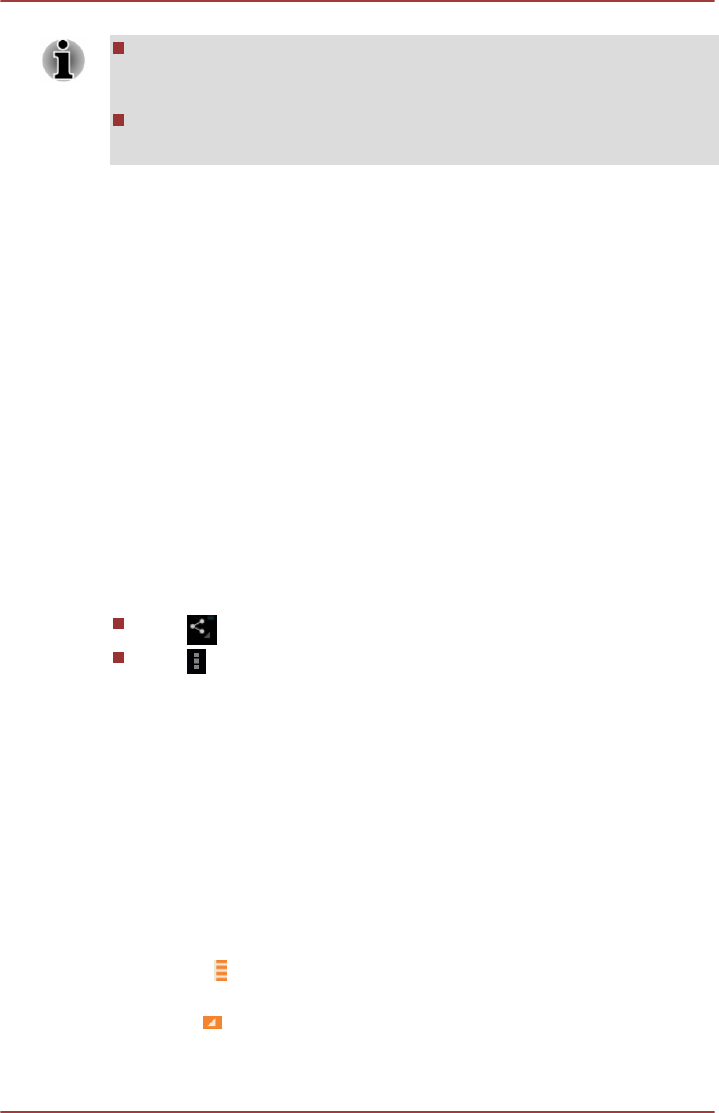
If you have a large number of pictures or videos on your tablet, it may
take Gallery a few minutes when you open it to discover and organize
them.
Gallery will display all images and videos without distinction of internal
or external storage.
View and browse pictures/videos
All the albums are displayed in the screen.
1. Tap an album to open it and view its contents. The pictures and videos
in the album are displayed in chronological order. You can view the
pictures and videos in your albums in stacks, sorted by Albums,
Locations,Times, People, and Tags.
2. Tap a picture or video in an album to view it.
You can pinch the picture by two fingers or apart to zoom in or zoom
out. Slide left or right to view other pictures/videos.
Take pictures/videos
You can also tap the camera icon to take pictures or videos directly. Refer
to the Camera section for more information.
Work with pictures/videos
After opening a picture or a video, you can work with it as follows:
Tap to share photo or video with other applications.
Tap to find several options on the photo/video screen. Detailed
options are different between the photo and video screen.
The Google Play™ Music App
You can use the Google Play Music app to organize and listen to music
and other audio files stored on your tablet or SD card.
The app supports a wide variety of audio files formats so it can play music
that you purchase from online stores, or copied from external storage and
so on.
To open the Music screen, tap All Apps -> Play Music.
A screen requring you to sign in with a Google™ account will appear. You
can tap Add account to sign in or tap Not now to skip.
You can tap to choose to open Listen Now, My Library or Playlists
screen.
By tapping , you can choose the music from All music or On device.
User's Manual 5-6

Playing music
You can listen to music by tapping a song you like.
Working with playlists
You can create playlists to organize your music files into sets of songs,
which you can play in the order you set or in a shuffle.
To create a playlist, you can add the songs that are playing by tapping
beside the song and tapping Add to playlist. Choose an existing playlist,
or tap New playlist to create a new playlist.
People
People is a phonebook application to organize phone number, email
address, and other profiles of your friends or acquaintances.
Information about your contacts is shared with other applications.
If you have more than one account with contact information, People
merges duplicate contacts into a single entry. You can also manage that
process manually.
Open People
To open your contact, tap All Apps -> People.
All of your contacts are displayed alphabetically in a scrolling list.
Tap a contact to view the details. Entries for communicating with the
contact are followed by details.
Import and export contacts
To import/export your contacts, tap menu ( ) icon and then tap Import/
export.
Search for a contact
You can search for a contact by name.
1. Tap Find contacts ( ). The search box appears.
2. Start entering the name or number of the contact you’re searching for.
As you type, contacts with matching names appear below the search
box.
3. Tap a matching contact in the list to open its details screen.
Service Station
The Service Station utility is used to provide you with updates for both
applications and system software. It will notify you when a new version of
software is available, also it initiates for download & installation.
User's Manual 5-7
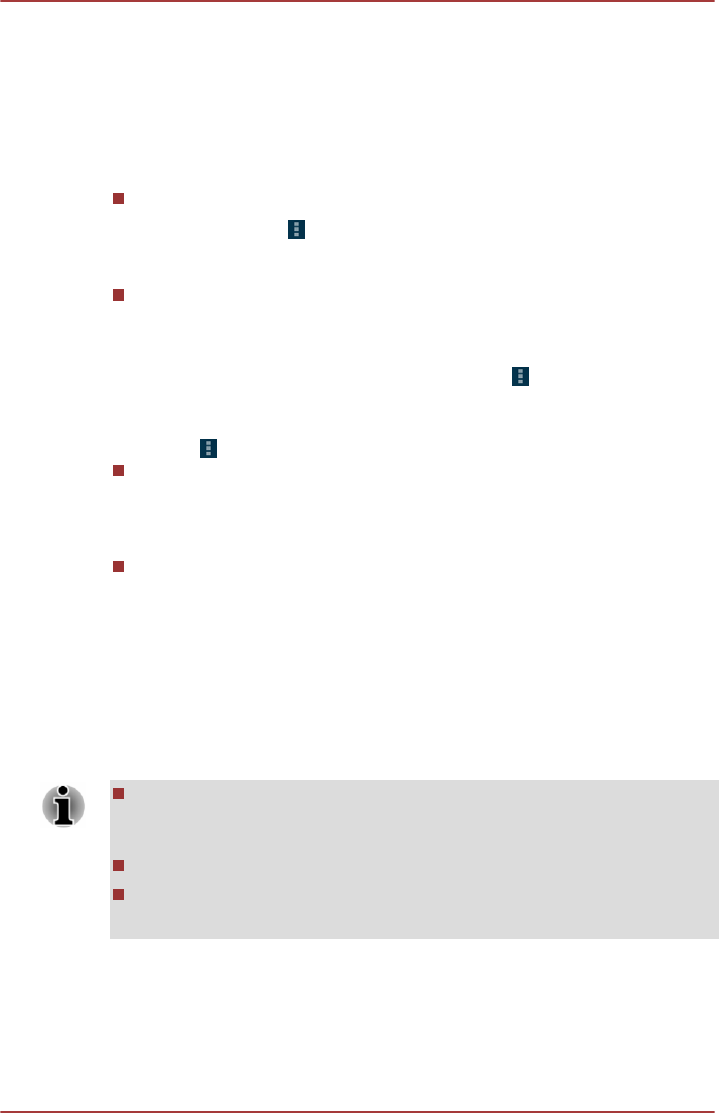
To open Service Station:
Tap All Apps -> Service Station.
Main Window
The main window of this application includes four areas: Menu, Buttons,
Information, and Check for Updates.
Menu
Tap Menu icon ( ), you can access the following options: Select All
Applications, View Hidden Update(s), View Hidden Alert(s), View
Access Agreement, and About.
Buttons
Two buttons are displayed in this area:
Software Updates: Tap to check the System and application updates.
To view the hidden updates, tap Menu icon ( ) and select View
Hidden Update(s).
Alerts: Tap to check the alerts. To view the hidden alerts, tap Menu
icon ( ) and select View Hidden Alert(s).
Information
The main part of the screen displays information such as the list of
available updates, or more detailed information about a specific
update.
Check for Updates
Tap the Check for Updates button, and the application will refresh the
list of available updates.
During normal operations, the Service Station will periodically check to
see if there are any updates for your system. This is done
automatically. If there are new updates available, you will be notified
with the Service Station icon in the System bar of your tablet.
While the Service Station will periodically check for updates in the
background, you can request that it check for updates immediately.
It is not normally necessary to check for updates manually, as the
utility checks for them automatically and informs you when one is
available.
Connect the AC adaptor before updating.
If the tablet has multiple users, system update is available only for
owner account, while application update is allowed for all users.
You can also find the basic information about your system such as the
version of the operating system, the tablet part number and serial
number in this area.
User's Manual 5-8
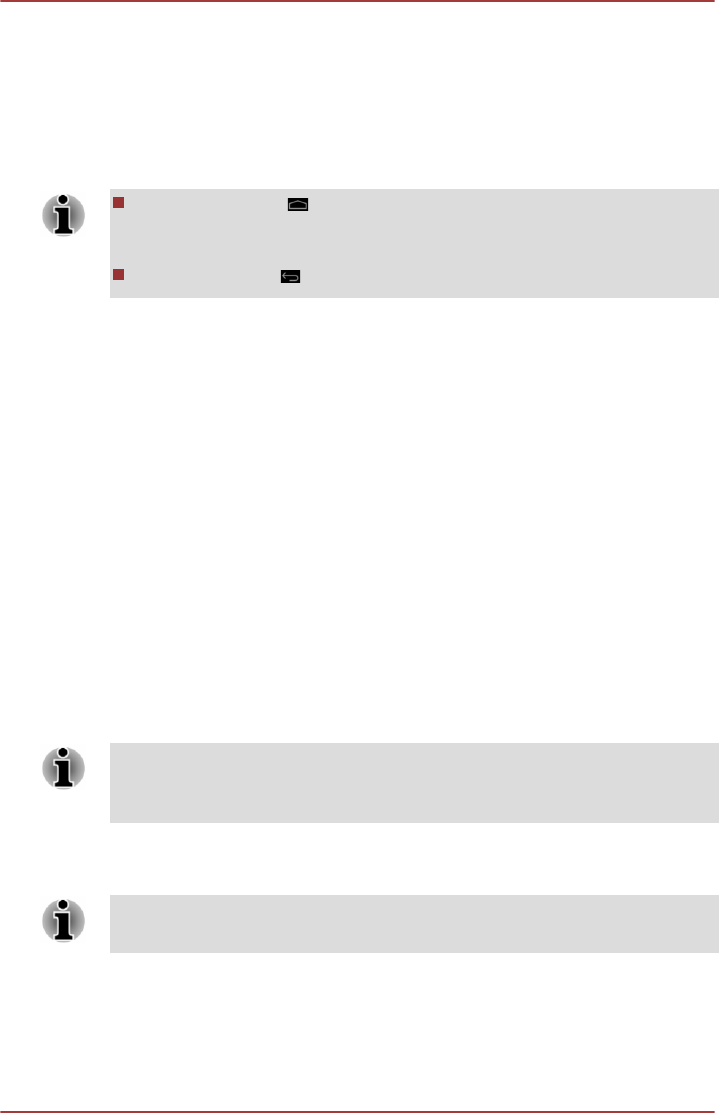
Downloading Updates
When an update is available, it will appear on the information area of the
screen. Tap the item displayed. More details for that item are displayed on
the screen.
To download the update, tap the Download button. This will begin the
download process. A progress indicator is displayed.
Tapping Home ( ) allows the download to continue while you use
your tablet. A notification of the download completion will appear in the
system bar.
Tapping Back ( ) will abort the download process.
Installing Updates
Once an update has been downloaded, it can be installed. If you are not
able to see the information in System bar, go to the screen by launching
the Service Station utility, or by tapping the download completion notice on
the system bar.
Tap the Install button. This will launch the application installer. Continue
with installation.
Downloading and Installing System Updates
Service Station will download both application and system updates. System
updates require a reboot of your tablet.
Downloading a system update is the same as an application update.
Installing a system update is similar to an application update, but you will
be reminded that the tablet will be rebooted during the installation process.
Make sure to close any other applications and save all work prior to
installing a system update.
It is important to ensure that a system update will not be interrupted after it
has started. Plug in the AC power before starting the installation and don’t
turn the tablet off until the process has finished.
Note that the system may reboot more than once during an system update,
depending on the update itself.
This application only updates system area in the internal storage. User
data area is retained after the system is updated.
TOSHIBA File Manager
TOSHIBA File Manager is a featured application that manages files and
folders. It allows you to create, rename, copy, cut, paste or delete files, and
folders stored in both internal and external storage.
User's Manual 5-9
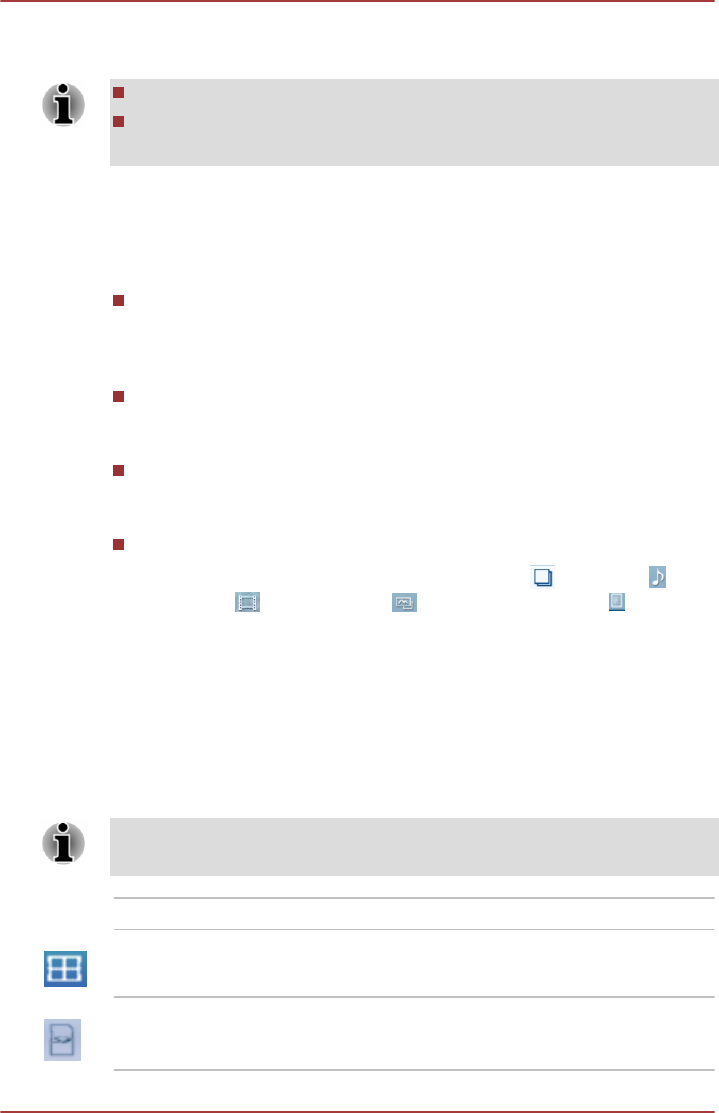
To open TOSHIBA File Manager, tap All Apps -> File Manager from the
Home screen.
System files cannot be accessed by TOSHIBA File Manager.
TOSHIBA File Manager may not be able to open a file without its
associated application.
Navigation
The main window of TOSHIBA File Manager is divided into four panels.
Each panel’s function is described as below.
Device panel
Device panel lists buttons of available storage devices. By default you
will see Internal Storage and Screen Capture buttons. You are also
allowed to add folder shortcut into this panel.
Address panel
Address panel shows you the current device name followed by relative
(not full) path of current folder.
Control panel
Control panel contains several functional icons for file and folder
operations.
Files and folders panel
This panel is divided into five categories: ALL ( ), MUSIC ( ),
VIDEOS ( ) , PICTURES ( ) , and DOCUMENTS ( ) , you can
tap to view as you want.
Explore files and folders with optional layout in this panel. You can
read and collect additional information such as size, thumbnail of the
files, name, last modified date, and time of the folders.
Storage Structure
The following table lists the description of each storage device icon in the
Device panel.
TOSHIBA File Manager only shows the storage device connected to the
tablet.
Name Description
Internal Storage All contents (excluding system files) in the
tablet’s internal storage are shown.
SD card All contents in SD card are shown.
User's Manual 5-10
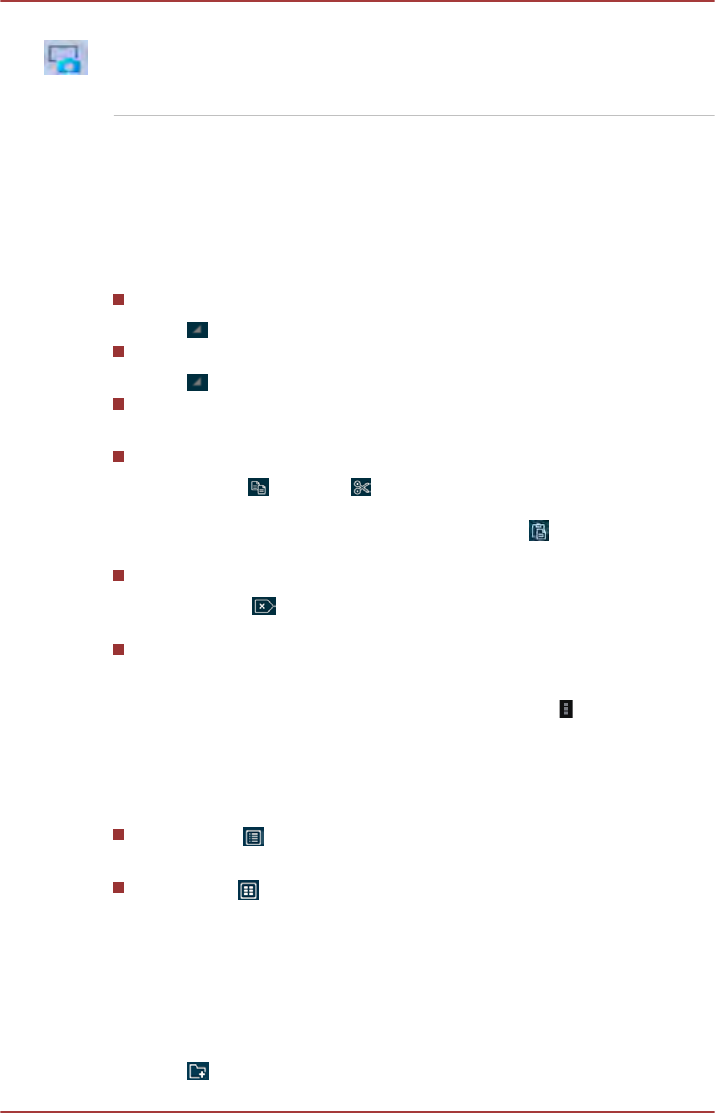
Screen Capture Screenshots image files are shown.
Refer to the Capturing your screen section for
more information.
Operations on Files & Folders
Basic file operations
You can Cut, Copy, Paste, and Delete files & folders. Press & hold an
item to select it while enabling the multi-selection mode, therefore these
command buttons will be visible in the Control panel.
Select All
Tap to open the menu and tap Select All.
Deselect All
Tap to open the menu and tap Deselect All.
Cancel Selection
Tap Done to cancel selection.
Copy, Cut, and Paste
Tap Copy ( ) or Cut ( ) in the Control panel. After TOSHIBA File
Manager exits the multi-selection mode, you can redirect to a folder
where to paste the selected items. Tap Paste ( ) in the Control
panel to complete the operation.
Delete
Tap Delete( ) in the Control panel to delete the item(s) you have
selected. Confirm the operation by tapping OK.
Share
Items can be shared with the other applications such as Email.
To do this, first select the items and then tap icon ( ). Tap Share
from the menu and select the app you want.
Grid/List view
You can switch GridView/ListView by tapping either of the following icons.
Grid view( )
By default, files and folders are shown in a gird.
List view( )
Files and folders are shown in a scrolling list enabling you to view
detailed information about an item.
Creating a folder
You can create a folder by following below steps:
1. Navigate to the directory where to create a new folder.
2. Tap in the Control panel.
User's Manual 5-11
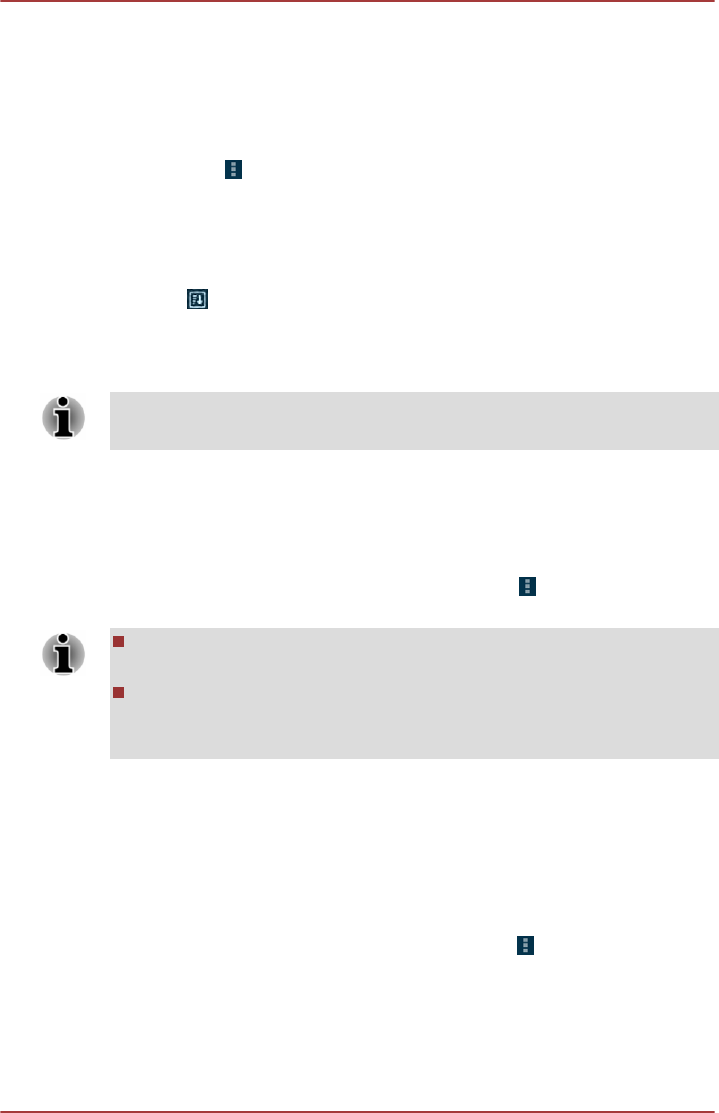
3. A dialog will appear, enter the folder name and tap OK.
Renaming a file or a folder
You can rename a file or folder by following the steps below:
1. Press & hold a file or folder you want to rename.
2. Tap icon to open the menu and tap Rename.
3. A dialog will appear. Enter a new folder name and tap OK.
Sorting files and folders
You can sort and view files and folders by name, time, size, and type.
1. Tap in the Control panel.
2. Tap By name, By size, By time or By type as you want.
By default, items are arranged in ascending order. Tap the option to switch
to descending order.
Only some options are supported in MUSIC, VIDEOS, PICTURES, and
DOCUMENTS tabs.
Adding folder shortcut
Folder shortcut makes it faster to access the folder. TOSHIBA File
Manager is designed to create folder shortcut in the Device panel.
1. Press & hold a folder to select it, and then tap to open the menu.
2. Tap Add to shortcut to add it to the Device panel.
This operation is only applicable to folders saved in the internal
storage.
To remove a folder shortcut from the Device panel, press & hold the
shortcut and tap OK. However, the storage device icon cannot be
removed.
TruCapture
This software is a camera application with special features to take
improved snapshots of whiteboards, printed materials, notebooks, etc.
To open TruCapture, tap All Apps -> TruCapture.
The Tutorial providing the information about how to use this feature will
appear. You can also find it by tapping the Menu ( ) and selecting
Tutorial on the main screen of TruCapture.
Online Manual
Online Manual is an application to launch the pre-installed online manual
(this manual) for this tablet.
User's Manual 5-12

Chapter 6
Settings
This chapter describes the Settings app - a quick and easy access to the
global options that allows you to configure how your tablet communicates
and functions.
A scrollbar is displayed on the right side of the screen. This scrollbar is
only used to show the position of the displaying area. You can scroll
the screen using your fingers.
Some settings are only available to the tablet owner.
Wireless & networks
Your tablet can connect to a variety of networks and devices, mobile
networks for voice and data transmission, Wi-Fi data networks, and
Bluetooth devices, such as headsets.
Options under WIRELESS & NETWORKS, which are briefly described
below, are used to configure and manage these connections. You can tap
More to get additional hidden options.
Refer to the following sections in this chapter for more details.
Wi-Fi
Tap to see available Wi-Fi networks when Wi-Fi is turned on.
Bluetooth
Tap to see available Bluetooth devices when Bluetooth is turned on.
Data usage
Tap to monitor your current or historical data usage.
Airplane mode
Check to enable Airplane mode.
All wireless communications are disabled when Airplane mode is
enabled.
VPN
Tap to set up and manage Virtual Private Networks (VPNs).
User's Manual 6-1

Tethering & portable hotspot settings
You can share your tablet’s mobile data connection with other devices
(up to 8) via USB, Bluetooth, or by turning your tablet into a portable
Wi-Fi hotspot.
Tap to adjust these settings.
This function is only supported by 3G models.
Mobile networks
Tap to set up your wireless service provider’s mobile network.
This function is only supported by 3G models.
Wi-Fi networks
Wi-Fi is a wireless networking technology that can provide Internet access
at distances of up to 100 meters, depending on the Wi-Fi router and your
surroundings.
To use Wi-Fi on your tablet, you need to access a wireless access point, or
“hotspot”. If access points are opened you can simply connect to them.
Others are hidden or implement other security features, so you must
configure your tablet so it can connect to them.
There are numerous systems for securing Wi-Fi connections, including
some that rely on secure certificates or other schemes to ensure that only
authorized users can connect.
Turn off Wi-Fi when you are not using it to extend the life of your battery.
The Status bar displays icons that indicate Wi-Fi status.
Connected to a Wi-Fi network (waves indicate the
wireless connection strength)
Notification that an open Wi-Fi network is in range
Turning Wi-Fi on and connecting to a Wi-Fi network
You can turn on and connect to a Wi-Fi network by following steps:
1. Open the Settings app from All Apps.
2. Under WIRELESS & NETWORKS, tap Wi-Fi.
3. Slide the Wi-Fi switch to the ON position.
The tablet scans for available Wi-Fi networks and displays the names
of those it finds. Secured networks are indicated with a lock icon.
If the tablet finds a network that you connected to previously, it will connect
to it automatically.
User's Manual 6-2

4. Tap a network name to see more details.
If the network is open, you are prompted to confirm that you want to
connect to that network by tapping Connect.
If the network is secured, you’re prompted to enter a password or
other credentials. (Ask your network administrator for details.)
When you have connected to a network, tap on the network name for
details about the status, signal strength, link speed, security type, and
IP address.
Adding a Wi-Fi network
You can add a Wi-Fi network so the tablet will remember it, along with any
security credentials, and connect to it automatically when it is in range. You
must also add a Wi-Fi network to connect to it, if it does not broadcast its
name (SSID), or to add a Wi-Fi network when you are out of range.
To join a secured network, you need to contact the network’s administrator
to learn what security system is deployed and to obtain the password or
other required security credentials.
1. Turn on Wi-Fi if it is not already on.
2. In the Wi-Fi settings screen, tap the plus icon ( ).
3. Enter the Network SSID (name). If the network is secured, tap
Security and then tap the type of security deployed on the network.
4. Enter the required security credentials.
5. Tap Save.
The tablet will connect to the wireless network. Any credentials that
you enter will be saved, so you can connect automatically the next
time you come within range of this network.
Forgetting a Wi-Fi network
You can make your tablet forget about the details of a Wi-Fi network that
you added. For example, if you don’t want the tablet to connect to it
automatically or if it is a network that you no longer use.
1. Turn on Wi-Fi if it’s not already on.
2. In the Wi-Fi settings screen, tap the network name.
3. Tap Forget in the dialog that opens.
Modifying a Wi-Fi network
You can modify each connected Wi-Fi network settings including
credentials, proxy server settings and IP settings.
Proxy server settings may be required for some internal or external network
connection. By default, the Wi-Fi networks you add are not configured to
connect via a proxy server, but you can change that for each Wi-Fi network
you've added.
User's Manual 6-3

Proxy settings are used by Browser and may not be used by other apps.
1. In the Wi-Fi settings screen, press & hold the network name you have
added.
2. Tap Modify network.
3. Check Show advanced options.
4. If the network has no proxy settings, tap None and select Manual.
5. Enter the required proxy settings you have obtained.
6. Tap Save.
A static IP address may also be manually configured for some network. By
default, the Wi-Fi networks you add are configured for automatic IP
assignment. You can change it for each Wi-Fi network you've added.
1. In the Wi-Fi settings screen, press & hold the network name you have
added.
2. Tap Modify network.
3. Check Show advanced options.
4. If the network has no manual IP settings, tap DHCP and select Static.
5. Enter the required IP address you have obtained.
6. Tap Save.
Advanced Wi-Fi settings
Advanced Wi-Fi settings are available following the steps below.
1. Turn on Wi-Fi if it is not already on.
2. In the Wi-Fi settings screen, tap the Menu icon ( ) and tap
Advanced.
Several options are described below.
Network notification
By default, when Wi-Fi is on, you receive notifications in the Status bar
when your tablet detects an open Wi-Fi network. Uncheck this option
to turn off notifications.
Keep Wi-Fi on during sleep
Tap this option to change the setting:
Always: Stay connected to Wi-Fi always.
Only when plugged in: Stay connected to Wi-Fi only when the tablet
is connected to the AC adaptor.
Never: never to stay connected to Wi-Fi during sleep.
When your tablet supports 3G, Never option is likely to increase
mobile data usage. You may want to revisit this setting if you receive a
notification that you're approaching your specified mobile data limit.
Scanning always available
Check this option to enable Google Location Services and apps scan
for networks, even when Wi-Fi is off.
User's Manual 6-4
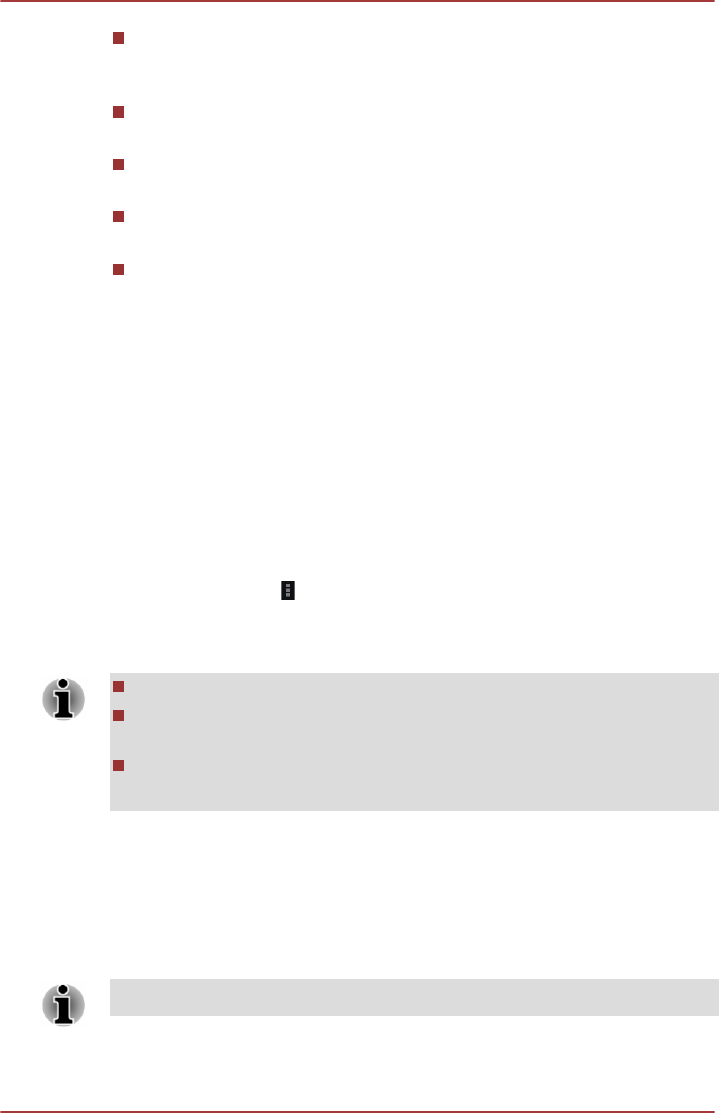
Wi-Fi frequency band
Tap this option to change the setting to Auto, 5 GHz only or 2.4 GHz
only.
Install certificates
Installs network certificates stored on the SD card.
Wi-Fi optimisation
Check this option to minimize battery usage when Wi-Fi is turned on.
MAC address
Shows MAC address of your device
IP address
Shows IP address of your device.
WPS Pin Entry
WPS Pin Entry feature provides a much easier connection to a Wi-Fi
access point. WPS or Wi-Fi Protected Setup is a fairly secure way to
connect to a Wi-Fi network without having to enter a long, convoluted
password.
Wi-Fi Direct
Wi-Fi direct allows you to directly connect to devices nearby via Wi-Fi for
much higher-speed wireless communication. You can share files or
streaming videos/audios from other compatible devices.
Tap the Menu icon ( ) and tap Wi-Fi Direct to enable Wi-Fi direct. Tap
SEARCHING FOR DEVICES to find the nearby available devices whose
names will be listed under PEER DEVICES for connection.You can also
rename your device by tapping RENAME DEVICE option.
Wi-Fi should be connected before using Wi-Fi direct.
Wi-Fi direct may fail to work when both devices have connected to a
different hotspot.
Wi-Fi direct may fail to work when the Wi-Fi frequency band is
configured as 5 GHz only.
Bluetooth
Bluetooth is a short-range wireless communications technology that
devices can use to exchange information over a distance of about 8
meters. The most common Bluetooth devices are headphones for listening
to the music and other portable devices, including cell phones.
This tablet does not support Bluetooth connections via ad-hoc network.
User's Manual 6-5

To connect to a Bluetooth device, you must turn on your tablet’s Bluetooth
radio. The first time you use a new Bluetooth device, you must “pair” it with
your tablet so that they connect securely to each other. After that, you can
simply connect to a paired device.
Turn off Bluetooth when you’re not using it, to extend the life of your battery
between charges. You may also be required to turn Bluetooth off in some
locations. Bluetooth is turned off in Airplane mode.
Status bar icons indicate Bluetooth status.
Turning Bluetooth on or off
1. Open the Settings app from All Apps.
2. Under WIRELESS & NETWORKS, tap Bluetooth.
3. Slide the Bluetooth switch to the ON position to turn on the Bluetooth
and slide left to switch OFF .
Pairing your tablet with a Bluetooth device
You must pair your tablet with another device before you can connect to it.
Once you pair your tablet with another device, they stay paired unless you
unpair them.
1. Open the Settings app from All Apps.
2. Make sure that the Bluetooth is turned on.
Your tablet will scan for and display the names of all available
Bluetooth devices in range.
If the device you want to pair with is not included in the list, make it
discoverable. See the documentation that came with your device to
learn how to make it discoverable by your tablet, and for other
instructions for pairing.
3. If your tablet stops scanning before you make the other device
discoverable, tap SEARCH FOR DEVICES.
4. Tap on the name of the Bluetooth device in the list to pair it.
The devices pair with each other. If you’re prompted to enter a
passkey, try entering 0000 or 1234 (the most common default
passkeys), or consult the documentation that came with the device to
learn its passkey. If the pairing is successful, that means your tablet is
connected to the device.
To display received files from other Bluetooth-enabled devices, tap the
Menu icon ( ) and tap Show files received.
Connecting to a Bluetooth device
Once paired, you can connect to a Bluetooth device. For example, to
switch between devices or to reconnect after your tablet and this device
come back into range.
1. Open the Settings app from All Apps.
User's Manual 6-6

2. Make sure that the Bluetooth is turned on.
3. In the list of Bluetooth devices, tap a paired but unconnected device. If
the device you expected isn’t displayed, tap SEARCH FOR DEVICES.
When your tablet and this device are connected, this device is shown
as connected in the PAIRED DEVICES list.
Configuring a Bluetooth device
Some Bluetooth devices have multiple profiles. Profiles can include the
ability to transmit your conversations, play music in stereo, or transfer files
or other data. You can select profiles you want to use with your tablet. You
can also change the name of the Bluetooth device as it appears on your
tablet.
1. Make sure that the Bluetooth is turned on.
2. Tap the icon ( ) beside a paired Bluetooth device.
A screen opens that allows you change the device profile or unpair it.
Configuring Bluetooth settings
Your tablet has a generic Bluetooth name by default, which is visible to
other devices when your connect them. You can change the name so that
it is more recognizable.
1. Open the Settings app from All Apps.
2. Make sure that the Bluetooth is turned on.
3. In the Bluetooth settings screen, tap the Menu icon ( ) and tap
Rename tablet.
4. Enter a new name for your tablet.
5. Tap Rename to complete the operation.
To set a time period which you want your device detected by other devices:
1. Tap the Menu icon ( ) and tap Visibility timeout .
2. Then select a period of time you want.
Mobile networks
This section only applies to models with 3G modules.
When you assemble your tablet with a SIM card from your wireless service
provider, your tablet is configured to use your provider’s mobile networks
for transmitting data.
Your tablet is configured to work with many mobile carriers’ networks. If
your tablet does not connect to a network when you insert a SIM card and
turn it on, contact your carrier to obtain & confirm Access Point Name
(APN) details.
User's Manual 6-7
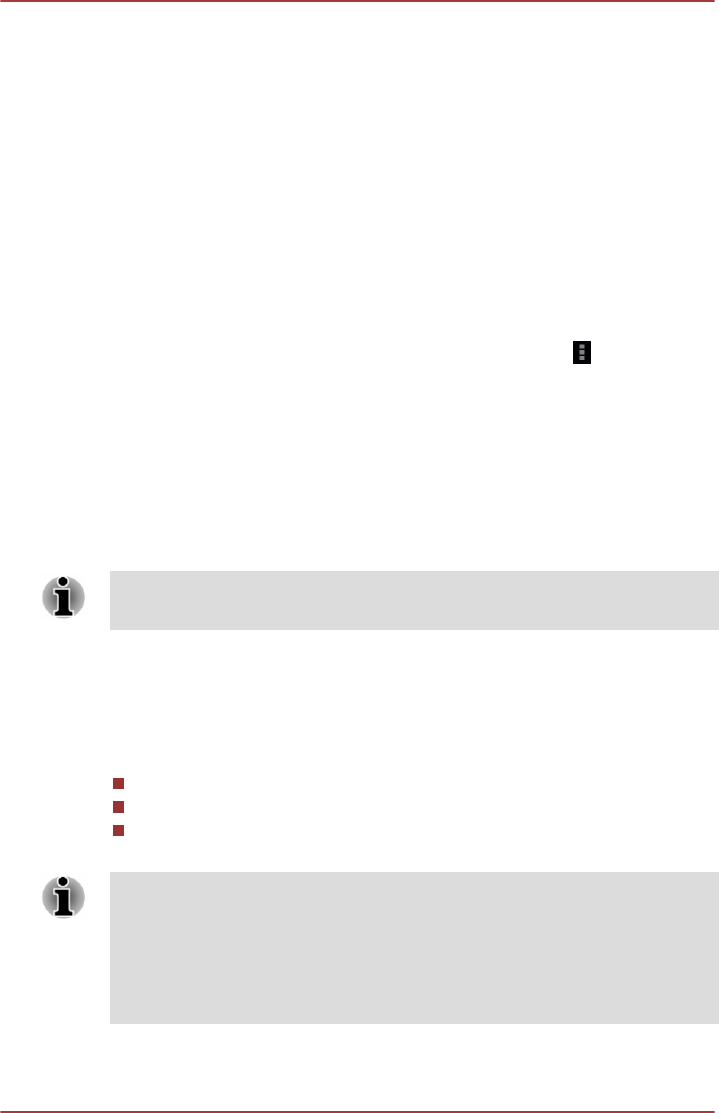
Disabling data when roaming
1. Open the Settings app from All Apps.
2. Under Wireless and networks, tap More -> Mobile networks, and
uncheck Data roaming. However you can still transmit data via a Wi-
Fi connection.
Editing or creating a new access point
If you and your wireless service provider determine that you need to
change the settings of your current APN or to create a new one, you must
obtain the APN and detailed settings from your provider.
1. Open the Settings app from All Apps.
2. Under Wireless and networks, Tap More -> Mobile networks ->
Access Point Names.
3. Tap an existing APN to edit it, or tap the Menu icon ( ) and select
New APN to create a new one.
Enter the APN settings that you obtained from your wireless service
provider by tapping each setting that you need to edit.
4. When you finished, tap Save.
If you have created a new APN, tap it in the APNs screen to start
using it.
Data usage
Some of the features described in this section apply only to models with 3G
modules.
Data usage refers to the amount of data uploaded or downloaded by your
tablet during a given period. Additional fees may be charged when the data
usage exceeds the limit depending on your wireless service provider’s
plan.
Data usage settings allow you to:
View data usage by apps
Enable or disable app auto-sync data
Enable or disable app data transfer in the background for mobile
hotspots
The information displayed on the data usage settings screen is measured
by your tablet. Your wireless service provider’s data usage accounting may
differ. Steep overage charge is possible in excess of your wireless service
provider’s data limits.
Data usage can help you to view and track data usage but it is not
guaranteed to prevent additional charges.
User's Manual 6-8

Setting data usage
Data usage of each network type (Mobile, Wi-Fi or Ethernet) are illustrated.
By default, Wi-Fi or mobile network is displayed.Tap the network tab to
switch between them.
Tap Data usage cycle to choose a different cycle. This date range is the
period for which data usage is displayed in the graph below.
The vertical white lines on the graph show a period of time within the data
usage cycle. You can drag the lines to change the period which determines
the total data usage amount below the graph.
The orange line indicate the level where you want to receive a warning
notification when the data usage reaches this level. Drag the line to adjust
the level.
The red line indicating the data limit appears after you check Set mobile
data limit. Drag the line to the limit you want. When the data usage
reaches the limit, mobile network will be turned off automatically. You will
receive a notification.
Device
Options under DEVICE allow you to fine tune your tablet hardware.
Sound
You can control sound volume and ringtone from Settings -> Sound.
Sound contains the following options:
Volumes
Tap to open a dialog where you can drag a slider to set the volume
separately for music, video, games, notifications, and alarms.
System
Default notification sound
Tap to open a dialog where you can set the default notification
tone when you receive a notification.
Touch sounds
Check this option to play sound when tapping the screen.
Screen lock sound
Check this option to play sound when locking and unlocking the
screen.
Display
You can use Display settings to configure the brightness and other screen
settings.
Display contains the following options:
User's Manual 6-9
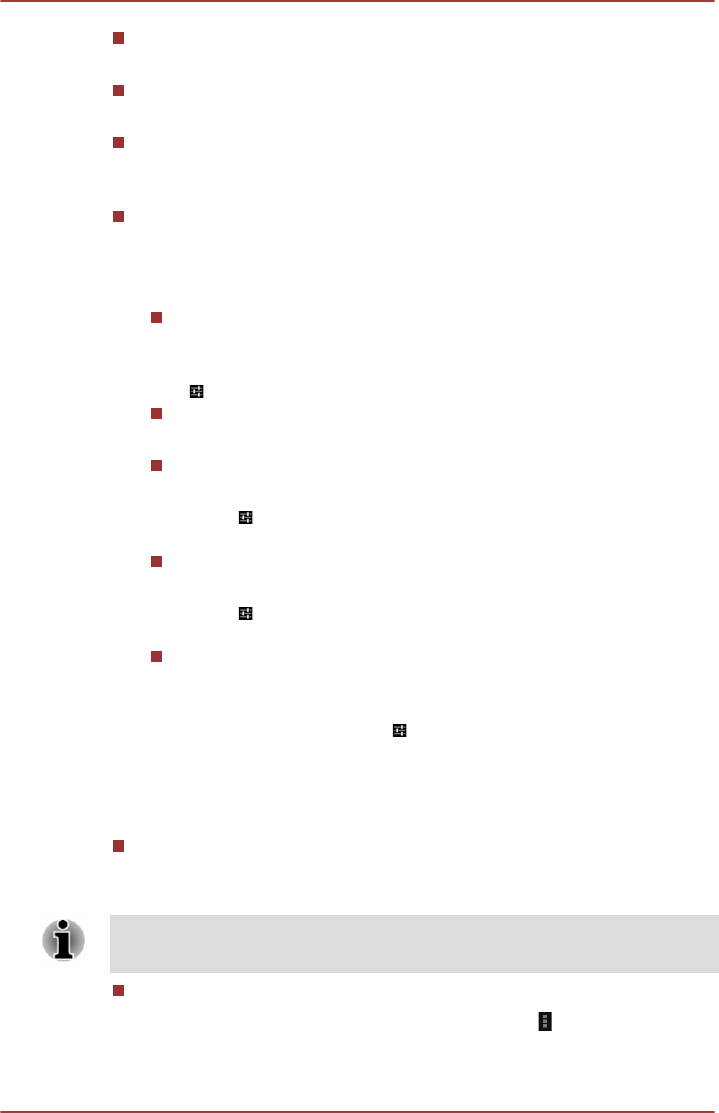
Brightness
Drag the slider left or right to adjust the screen brightness.
Wallpaper
Tap to select a wallpaper source and change wallpaper.
Sleep
Tap to open a dialog where you can set the time of inactivity before
the tablet goes to sleep.
Daydream
Slide the Daydream switch to the ON position. You can choose one of
the following options shown on the screen when the tablet is in sleep
mode.
Clock
Tap to select the Clock to show on the screen. You can change
the clock style or check the Night mode option by tapping icon (
).
Colors
Show changing colors on the screen.
Google Photos
Presents a slideshow of photos on your tablet. Tap Quick settings
icon ( ) to open a screen where you can select which photos to
be displayed.
Photo Frame
Presents a slideshow of photos on your tablet. Tap Quick settings
icon ( ) to open a screen where you can select which photos to
be displayed.
Photo Table
Scatters photos on your tablet across your screen. Press & hold a
photo to move it around the screen or swipe it away to hide it.
Tap Quick settings icon ( ) to open a screen where you can
select which photos to be displayed.
Once you have selected an option, you can tap START NOW to start
DAYDREAM immediately, or tap WHEN TO DAYDREAM to
determine when to sleep.
Font size
Tap to open a dialog where you can select the font size on the user
interface.
Some apps may not display texts properly if font size which is set as
Normal by default is changed.
Cast screen
Tap to open the screen and tap the Menu icon ( ) to configure
wireless display settings.
User's Manual 6-10

Storage
Storage shows your internal storage and external storage status.
Internal storage
Internal storage contains the following options:
Total Space
Shows the total memory space of internal storage in your tablet.
Available
Shows the free space of internal storage.
The following options will be displayed under the current user:
Apps (app data & media content)
The amount of application data of internal storage.
Pictures, Videos
The amount of picture and video data of internal storage.
Audio (music, ringtones, podcasts, etc.)
The amount of audio data of internal storage.
Downloads
The amount of downloaded data of internal storage.
Cached data
The amount of cached data for all apps of internal storage.
Misc.
The amount of miscellaneous data of internal storage.
You can also find the total storage amount of other users.
SD card
SD card contains the following options after you insert an SD card.
Total space
Shows total memory space of the SD card.
Available
Shows free space of the SD card.
Unmount SD card
Tap to unmount the SD card for safe removal.
Unmounting is not possible if the tablet is connected to a computer as a
removable MTP (Media Transfer Protocol). Disconnect the tablet from
computer before unmounting.
User's Manual 6-11

USB computer connection
You can choose how the USB port works by tapping the Menu icon ( )
and select USB computer connection. Refer to the Connecting to a
computer section for more details.
Battery
Battery allows you to check what is using the battery and the battery
usage data.
Tap to open a list of the applications and operating system components
you have used since you last connected the tablet to a power source,
sorted by the amount of power they have used.
Tap REFRESH on the top of the screen to reload the list.
Apps
You can use the Apps settings to view details about the applications
installed on your tablet, to manage their data and force them to stop.
Swipe between the four tabs at the top of the screen, each displaying a list
of apps or their components.
DOWNLOADED
Tap to open a list of all downloaded applications installed on your
tablet, along with their size. They are sorted by name alphabetically by
default.
RUNNING
Tap to open a list of all applications, services (applications or parts of
applications that provide services to other applications or that run even
when their main application isn’t running), processes that are currently
running and how much memory they are using. Depending on the
service, when you tap it in the list it will either open a dialog where you
can stop it or open its Settings screen.
ALL
Tap to open a list of all applications that you downloaded and all
applications that are pre-installed with your tablet.
DISABLED
Tap to open a list of applications disabled on your tablet.
This tab will appear only if any application is disabled.
You can tap the Menu icon ( ) and select Sort by size to switch the order
of the lists in Downloaded or All tabs.You can also use Reset app
preferences to reset all preferences for related settings, such as Disabled
apps and Disabled app notifications.
User's Manual 6-12
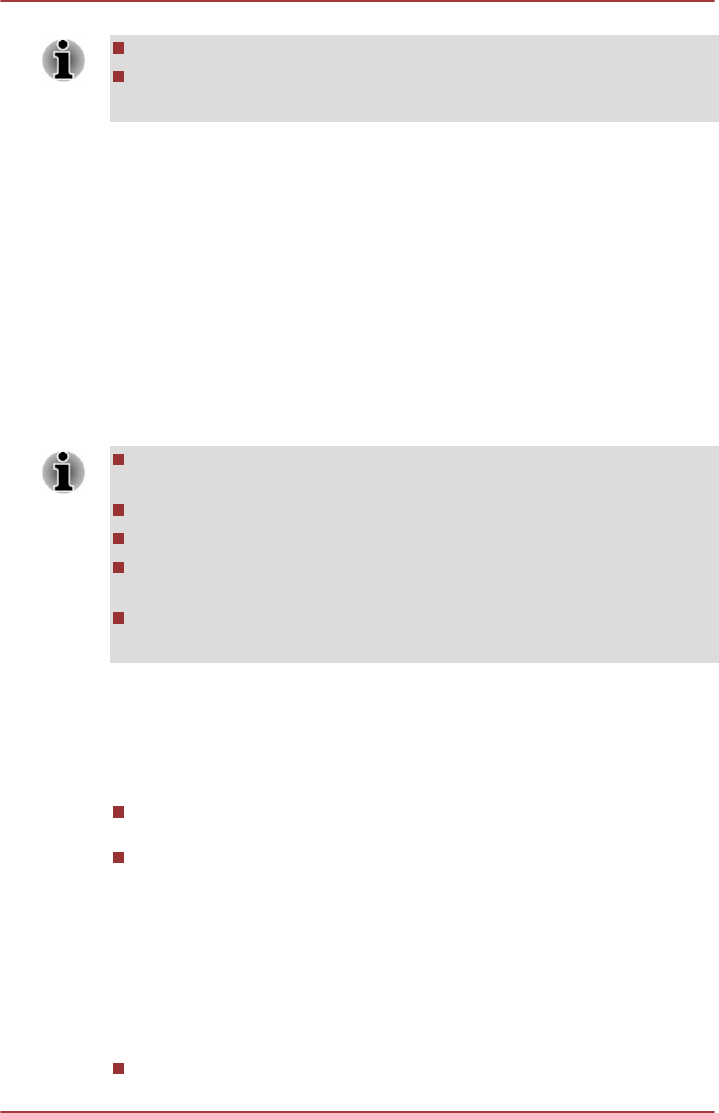
This tablet does not support another Operating System.
TOSHIBA cannot guarantee or support applications that are installed
by a user.
Users
You can add additional users and restricted profiles on your tablet.
Add users
You can share your tablet with family and friends. Each new user you set
up here can use a separate space on the tablet with its own Home screen,
account, apps, settings and so on.
You can create additional users on the tablet.
Each user’s image appears on the lock screen along with the tablet
owner’s image. To use the tablet, touch your image and unlock your own
lock screen.
Any user can accept the updated app permissions on behalf of any
other users.
Only the tablet’s owner can remove any user’s space completely.
Some options in Settings app are only available for owner.
The performance and response of the tablet may slow down when
background users are running applications.
New users cannot be created when the storage space is not enough in
the tablet.
Create a user
To add a user, you must be the owner.
Tap the Add user or profile and tap User. A dialog will appear, tap OK to
continue:
If the person is available, tap Set up now to enter the lock screen of
the new user and hand over the tablet to the person for setup.
If the person is not available, tap Not now. A new user appears in the
list.
When you can hand over the tablet to the person for setup, tap the
user image in Device -> Users under Settings app, or on the lock
screen.
Modify user information
Each user can modify his/her own image and information shown on the
lock screen:
Change image: tap the user name.
User's Manual 6-13
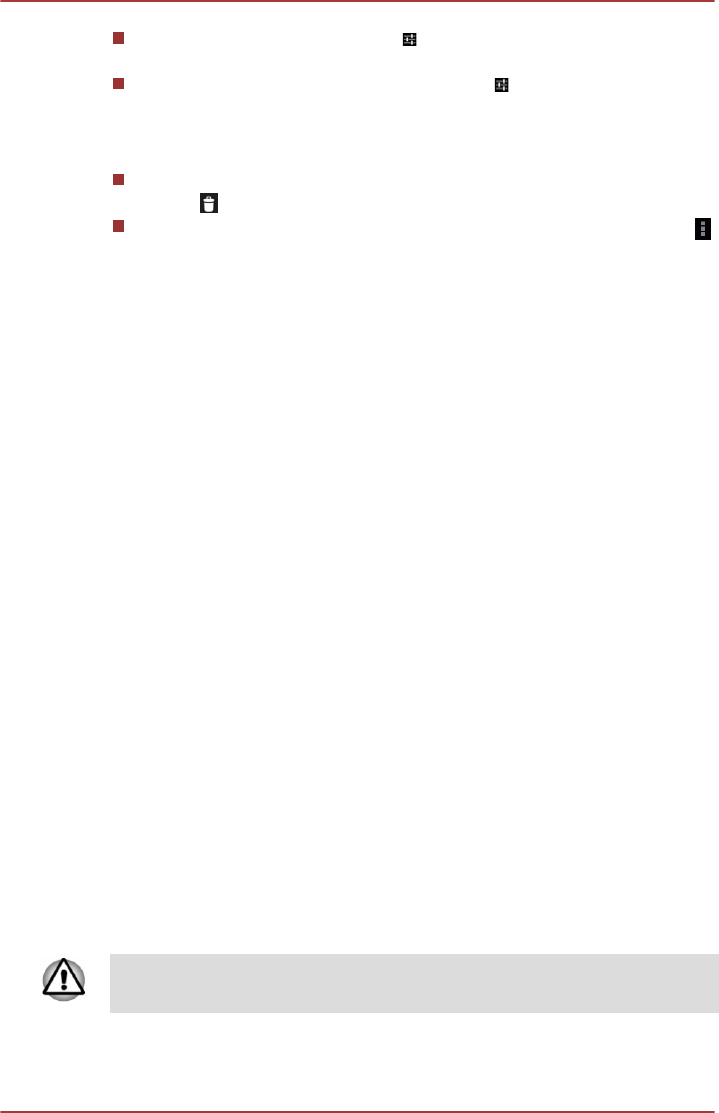
Change user name: tap icon ( ) to open a screen where you can
change user name.
Add or change additional text: tap icon ( ) to open a screen where
you can add or change the text displaying on the lock screen.
Delete a user
The tablet’s owner can delete any user’s space by tapping the Trash
icon ( ) beside the user name.
Other users can only delete their own space by tapping Menu icon (
) on the top right of the screen and select Delete from this device.
Switch users
Each user’s image and user name appear on the lock screen along with
the tablet owner’s. To enter your own space, tap your image and unlock the
screen with your screen lock.
Alternatively, swipe down from the top right of any screen to open Quick
Settings panel, and then tap your image near the top left. This returns you
to the lock screen, from which each user can unlock his/her own space.
Add restricted profiles
As the tablet owner, you can create restricted profiles so that other users
have restricted access to features and contents on your tablet. Before you
create a restricted profile, you will need to set up a screen lock to protect
your apps and personal data.
Create a restricted profile
1. Tap Add user or profile and tap Restricted profile. A new profile
with a list of applications displays. Tap New profile to name the
profile.
2. Slide the switch to the ON position for the applications and contents
that you want to grant access to.
When you hand over the tablet to the restricted user, only the granted apps
appear after the user touches the All Apps icon.
Edit a restricted profile
1. Tap the name of the restricted profile.
2. Slide the switch to the ON or OFF position for the applications and
contents that you want to grant or deny access to. The changes take
place in real time.
If you switch off an app, the profile user loses all contents associated with
that app. The contents can not be restored even if you grant access again.
User's Manual 6-14
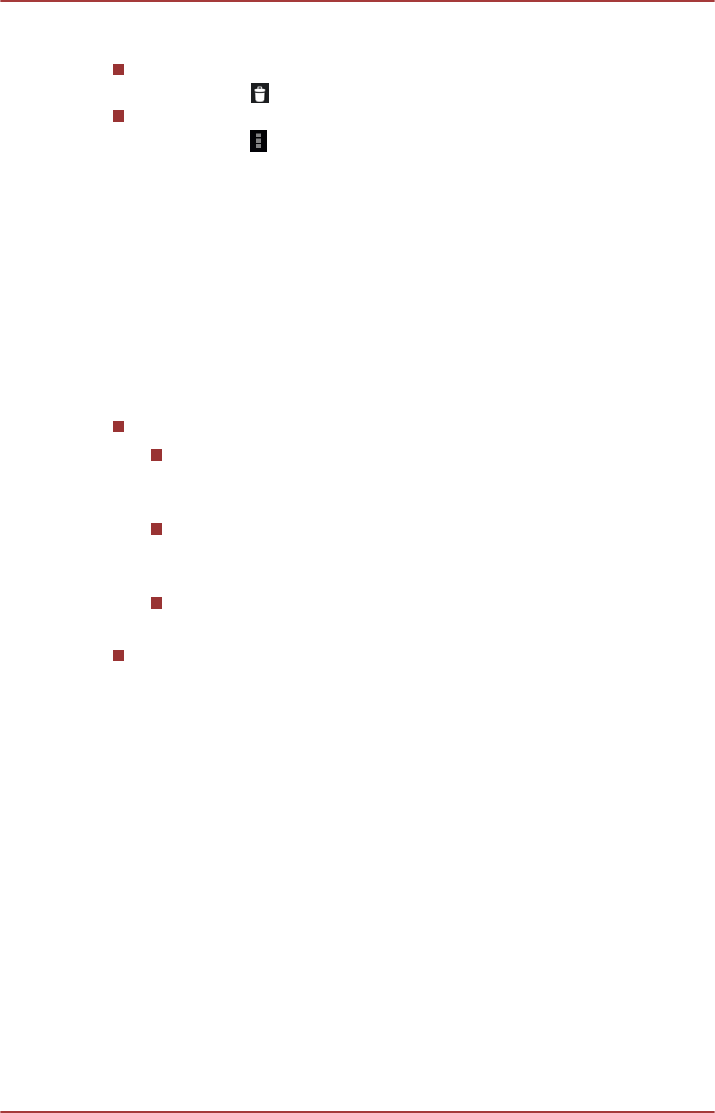
Delete a restricted profile
The tablet’s owner can delete any restricted profile by tapping the
Trash icon ( ) beside the profile be deleted.
Other restricted profiles can only delete their own space by tapping
Menu icon ( ) on the top right of the screen and selecting Delete
from this device.
Personal
Options under PERSONAL allow you to manage personal accounts, data
backup, and security.
Location
You can use Location settings to set location related settings.
Slide the Location switch to the ON position.Location contains the
following options:
Mode
High accuracy
Check this option to estimate your location faster and more
accurately using GPS, Wi-Fi, and mobile networks.
Battery saving
Check this option to estimate your location using low battery-
intensive location sources, such as Wi-Fi.
Device only
Check this option to estimate your location using GPS only.
Recent Location Requests
Display apps that have recently received your location.
Security
You can use Security settings to configure settings that help secure your
tablet and its data.
Security contains the following options:
User's Manual 6-15

Screen Security
Screen lock
Tap to open a screen where you can configure the tablet to lock
screen with a Slide, Face Unlock, Pattern, PIN, Password.
The following options will be displayed depending on the lock
mode you select.
Make pattern visible: Check to make the pattern visible while
unlocking the tablet.
Automatically lock: Tap to open a dialog where you can
configure the tablet to lock the screen Immediately or after a
period of time (5 seconds, 15 seconds,etc) when the tablet is in
the sleep mode.
Power button instantly locks: Check to lock the screen every
time when power button is pressed.
Improve face matching: Tap to record your face again under
better conditions like In different lighting, with or without
prescription glasses, bearded or clean-shaven.
Enable widgets: Check this option to enable widget on lock
screen. The default widget is digital clock. To add more, swipe
from the left edge of the widget to right untill you see a plus icon.
Liveliness check: Requires eye blink while unlocking if checked.
You can also choose None to disable screen lock. However,
when multiple users are setup, this option becomes unavailable.
Owner info or User info or Profile info
Tap to open a dialog where you can enter text to display on the
lock screen.
Encryption
Encrypt tablet
Tap to open a dialog where you can set numeric PIN or password
to decrypt your tablet each time you power it on.
A PIN or password must be set (using Screen lock option) before
encrypting your tablet.
SIM Card Lock
Set up SIM card lock
Tap to open a screen where you can configure the tablet to
require entering the SIM PIN to use the tablet and where you can
change the SIM PIN.
This function is only supported by 3G models.
User's Manual 6-16

Passwords
Make passwords visible
Check this option to show each password character as you enter
them, so that you can see what you enter.
Device Administration
Device administrators
Tap to open a screen where you can view and manage device
administrators.
Unknown sources
Check this option to permit installation of applications that are not
downloaded from or available on the Google Play™ store app.
Verify apps
Check this option to disallow or warn before installation of
applications that coud be harmful to your tablet.
Credential Storage
Storage type
This option shows the type of your storage.
Trusted credentials
Tap to open a screen where you can allow applications to access
your tablet’s encrypted store of secure certificates and related
passwords and other credentials. You can use credential storage
to establish some kinds of Wi-Fi connections. If you have not set
a password for credential storage, this setting is grayed.
Install from SD card
Tap to install a secure certificate from the SD card.
Clear credentials
Tap to delete all secure certificates and related credentials and
erases the secure storage’s own password, after prompting you
to confirm that you want to do this.
Language & input
You can use Language & input settings to select the language for the text,
voice input, and voice output on your tablet and for configuring the
onscreen keyboard, including words that you’ve added to its dictionary.
Language
Tap to select the system language from a list.
Spell checker
Tap to enable automatic spell check to fix misspelled words more
easily.
Tap the icon ( ) besides the option to configure it.
User's Manual 6-17

Personal dictionary
Tap to open your personal dictionary. To add your words, tap ADD on
the top right of the screen.
Keyboard & Input Methods
Default
Tap to open a dialog where you can select the default input
method you want to use, if you have more than one installed, tap
Set up input methods to open the screen where you can
configure each input method.
Physical Keyboard
This option is available when a physical keyboard is connected. Tap
on the name of the connected keyboard to configure the keyboard
layout.
Speech
Voice Search
Tap to open a screen where you can set the voice recognition
function.
Text-to-speech output
Tap to open a screen where you can set the text-to-speech
engine required for text-to-speech function.
Mouse/Trackpad
Pointer speed
Tap to set the mouse pointer speed by dragging the slider left or
right.
Backup & reset
You can use the Backup & reset settings to manage your personal data.
Backup & Restore
Back up my data
Check this option to back up application data, Wi-Fi passwords,
and other settings to Google servers.
Backup account
Tap to display the Google account that your settings and other
data are backed up with.
Automatic restore
Check this option to restore backup settings or other data when
you reinstall an application.
User's Manual 6-18
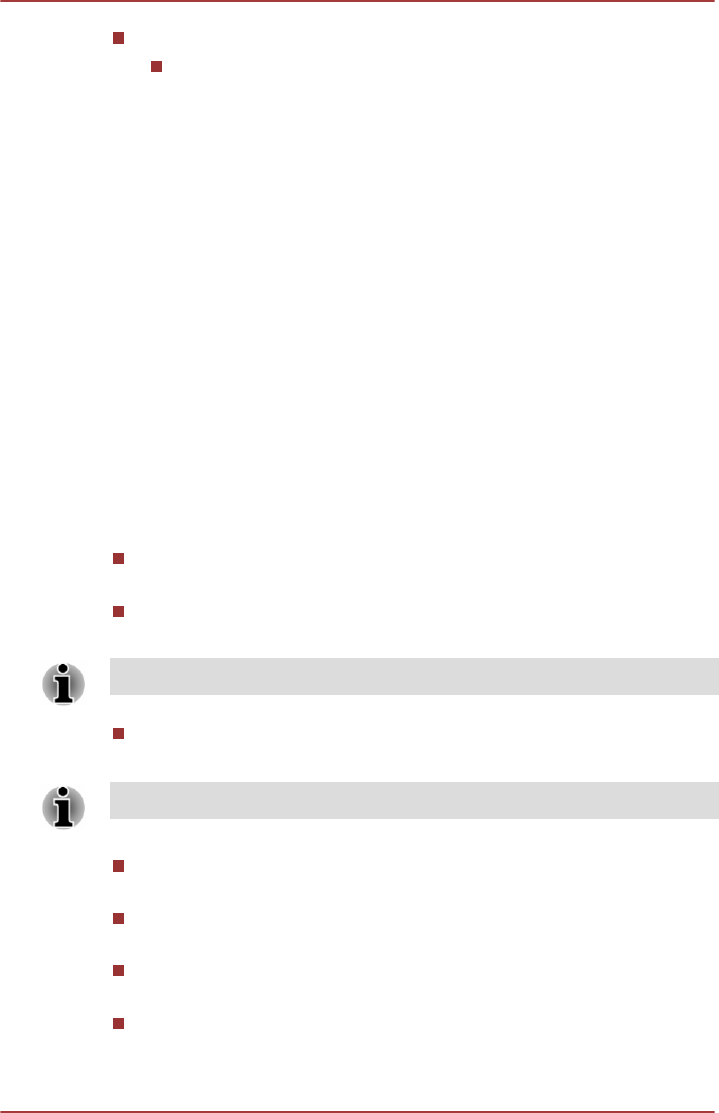
Personal Data
Factory data reset
Tap to erase all user data in the internal storage. Follow the on-
screen instructions to reset it. Note that data in the removable
media won’t be erased. Refer to the section Factory Reset in
"Basic" chapter for details.
Accounts
You can tap an account to edit account settings which may vary with
different account type.
Add account
Tap Add account to open account creation and setting screen of
applications.
System
Date & time
You can use Date & time settings to set your preferences for how dates
are displayed. You can also use these settings to set your own time and
time zone, rather than obtaining the current time from the mobile network.
Automatic date & time
Check this option to auto-sync time.
Automatic time zone
Check this option to auto-sync time zone.
This function is only supported by 3G models.
Set date
Tap to open a dialog to manually set the date.
The system date cannot be set beyond Dec/31/2037.
Set time
Tap to open a dialog where you can set the time manually .
Select time zone
Tap to open a dialog where you can set the time zone.
Use 24-hour format
Check this option to display the time using 24-hour time format.
Choose date format
Tap to open a dialog where you can select the format for displaying
dates.
User's Manual 6-19
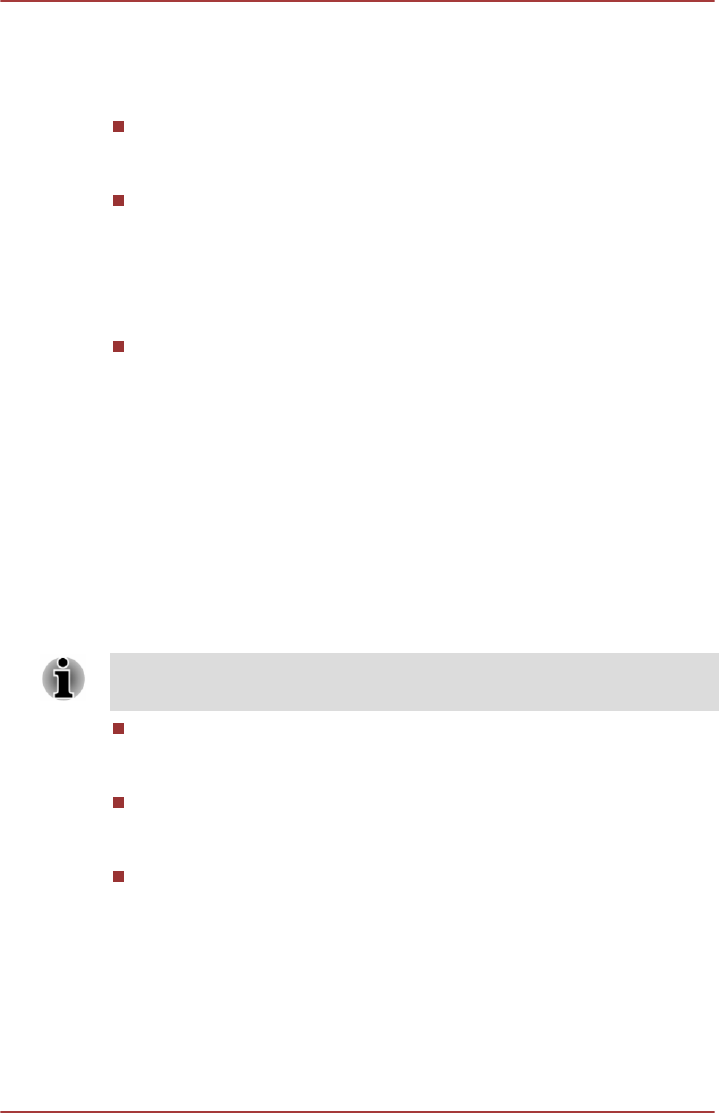
Accessibility
You can use Accessibility settings to enable accessibility functions, such
as reading or enlarging text on the screen.
TalkBack
Slide the switch to the ON position to enable TalkBack which provides
spoken feedback to help blind and low-vision users.
Captions
Captions allow the hearing impaired to specify if and how they want
captions displayed on video, for example, the language, size, and
color combinations.
Slide the switch to the ON position to turn on this feature.Then you
can configure the settings.
Magnification gestures
Slide the switch to the ON position to turn on this feature. Then you
can temporarily magnify what’s on your screen or use magnification
mode to easily zoom and pan your screen. This feature is developed
to help the low-vision users.
Temporarily magnify: Triple-tap & hold
Magnify & pan: Triple-tap & hold, then drag your finger.
Toggle magnification mode in or out: Triple tap & release, or enter
or exit an application to get out of magnification mode.
When you are in magnification mode, you can:
Pan: Drag two or more fingers across the screen.
Adjust zoom level: Pinch or expand using two or more fingers.
Triple-tap for magnification works everywhere except for the keyboard and
navigation buttons.
Large text
Check to increase the default font size used across the system for
better readability.
Auto-rotate screen
Check to make automatic screen rotation available as you turn your
tablet sideways.
Speak passwords
Check to enable this function that allows the tablet to speak the
passwords while you are typing.
User's Manual 6-20

Accessibility shortcut
Slide the switch to the ON position to turn on this feature, which allows
you to touch your tablet’s screen and hear what’s under your finger via
spoken feedback. This feature is helpful to blind users.
When this feature is turned on, you can quickly enable accessibility
features by the following steps:
1. Press and hold the power button until you hear a sound or feel a
vibration.
2. Touch and hold two fingers until you hear audio confirmation.
If the tablet has multiple users, use this shortcut on the lock screen
temporarily enables accessibility until the tablet is unlocked.
Text-to-speech output
Tap to select and set up speech engine that converts text into spoken
voice.
Touch & hold delay
Tap to select the delay required for your tablet to notice that you are
pressing and holding an item.
Printing
You can use printing function to print contents of certain screens.
About tablet
About tablet includes information about your tablet.
System updates
Tap to open the screen to check your system for update.
Status
Tap to open the Status screen with a long list of information about
your battery, network, and other details.
System information
Tap to open a screen that displays some basic information of your
tablet, such as Manufacture, Product name, Product version, and
Serial number, etc.
Legal information
Tap to open a screen where you can obtain legal information about
the softwares included with your tablet.
Model number
Display the model number of your tablet.
Android™ version
Display the current version of Android installed on your tablet.
Kernel version
Display the kernel version.
User's Manual 6-21

Baseband version
Display the baseband version.
This function is only supported by 3G models.
Build number
Display the build number.
User's Manual 6-22

Chapter 7
Optional Accessories
Optional devices can expand the tablet's capability and its versatility. This
section describes the connection or installation of the following devices:
Cards
Memory media slot
Secure Digital™ (SD) Card (microSD/SDHC/SDXC card)
SIM card
Peripheral devices
USB device
HDMI device
wireless display
Memory media slot
The tablet is equipped with a Memory media slot that can accommodate
some kinds of memory media with various memory capacities so that you
can easily transfer data from devices, such as digital cameras and
Personal Digital Assistants.
This Memory media slot supports the following memory media:
Secure Digital (SD) Card (microSD/SDHC/SDXC Card).
Please note that not all memory media have been tested and verified
to work correctly. Therefore, it is not possible to guarantee that all
memory media can operate properly.
Memory media
This section provides the important safety precautions in order to handle
your memory media.
Points to note about microSD/SDHC/SDXC memory cards
micro SD/SDHC/SDXC memory cards comply with SDMI (Secure Digital
Music Initiative), which is a technology adopted to prevent unlawful copy or
playback of digital music. For this reason, you cannot copy or playback
protected material on other device, and you may not reproduce any
copyrighted material except for your personal enjoyment.
The supported maximum capacity of memory card is 128GB.
User's Manual 7-1
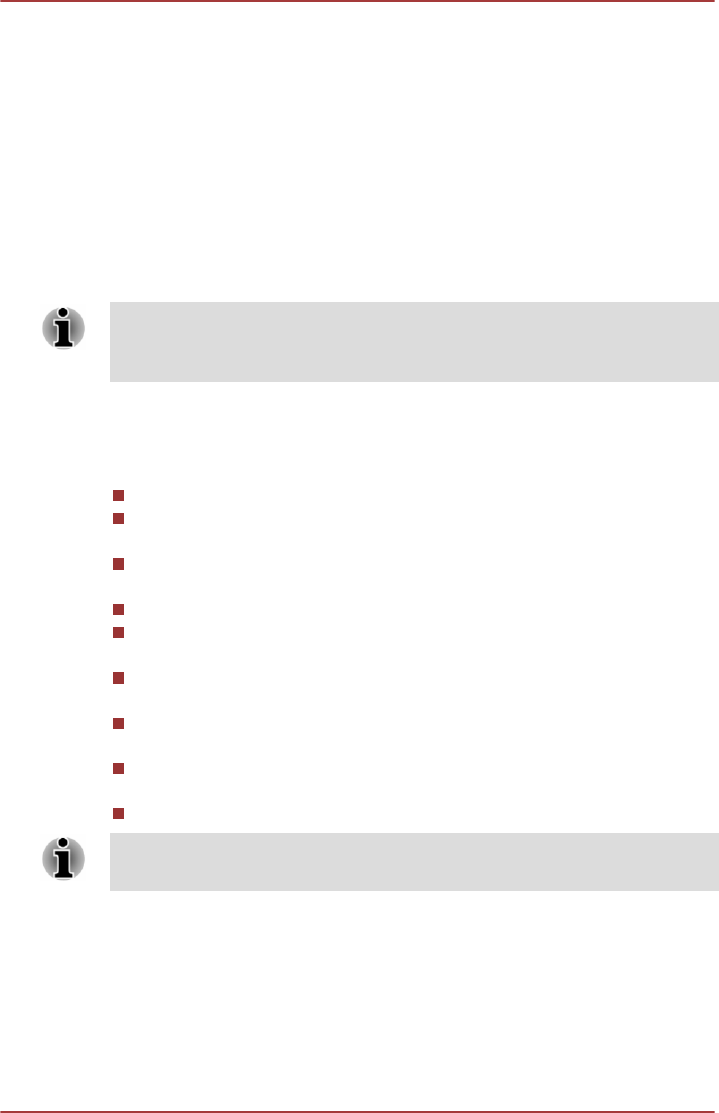
Memory media format
New media cards are formatted according to specific standards. If you wish
to reformat a media card, be sure to do so with a device that uses media
cards.
Formatting microSD/SDHC/SDXC memory cards
microSD/SDHC/SDXC memory cards are sold already formatted in
conformity to specific standards. If you reformat an microSD/SDHC/SDXC
memory card, be sure to reformat it with a device such as digital camera or
digital audio player that uses microSD/SDHC/SDXC memory cards, not
with the format command provided within Windows.
To format all areas of the memory card, including the protected area, you
must need to obtain an appropriate application that applies the copy
protection system.
Media care
Observe the following precautions when handling the card.
Do not twist or bend cards.
Do not expose cards to liquids or store in humid areas or lay media
close to containers of liquid.
Do not touch the metal part of a card or expose it to liquids or let it get
dirty.
After using card, return it to its case.
The card is designed so that it can be inserted only one way. Do not
try to force the card into the slot.
Do not leave a card partially inserted in the slot. Press the card until
you hear it click into place.
Memory cards have a limited lifespan, so it is important to backup
important data.
Do not write to a card if the battery power is low. Low power could
affect writing accuracy.
Do not remove a card while read/write is in progress.
For more details on using memory cards, see manuals accompanying the
cards.
Inserting a memory media
The following instructions apply to all types of supported media devices.
Follow the steps described below to insert a memory media card:
1. Turn the memory media so that the contacts (metal areas) are facing
down.
2. Insert the memory media into the memory media slot on the tablet.
User's Manual 7-2

3. Push the memory media gently until you hear a click.
Figure 7-1 Inserting a memory media
1
2
1. Memory media slot 2. Memory media
Make sure that memory media is oriented properly before you insert it.
If you insert the media in wrong direction, you might not be able to
remove it.
When inserting memory media, do not touch the metal contacts. You
could expose the storage area to static electricity, which can destroy
data.
Do not turn the tablet off nor switch to Sleep Mode while files are
being copied. Failure to do so can cause data loss.
Removing a memory media
The following instructions apply to all types of supported media devices. To
remove a memory media, follow the steps as detailed below:
1. Make sure all file operations are finished.
2. Tap All Apps -> Settings -> Storage -> Unmount SD card.
3. Push the memory media until you hear a click to partially release it.
4. Grasp it and pull it out of the slot.
Do not remove the memory media while the tablet is in Sleep mode. The
tablet could become unstable or data in the memory media could be lost.
SIM card slot
Some models are equipped with a SIM card slot that allows you to
assemble a SIM card from your wireless service provider to use your
provider’s mobile networks for transmitting data.
This section only applies to models with 3G modules.
Inserting a SIM card
This section explains how to insert a SIM card:
User's Manual 7-3
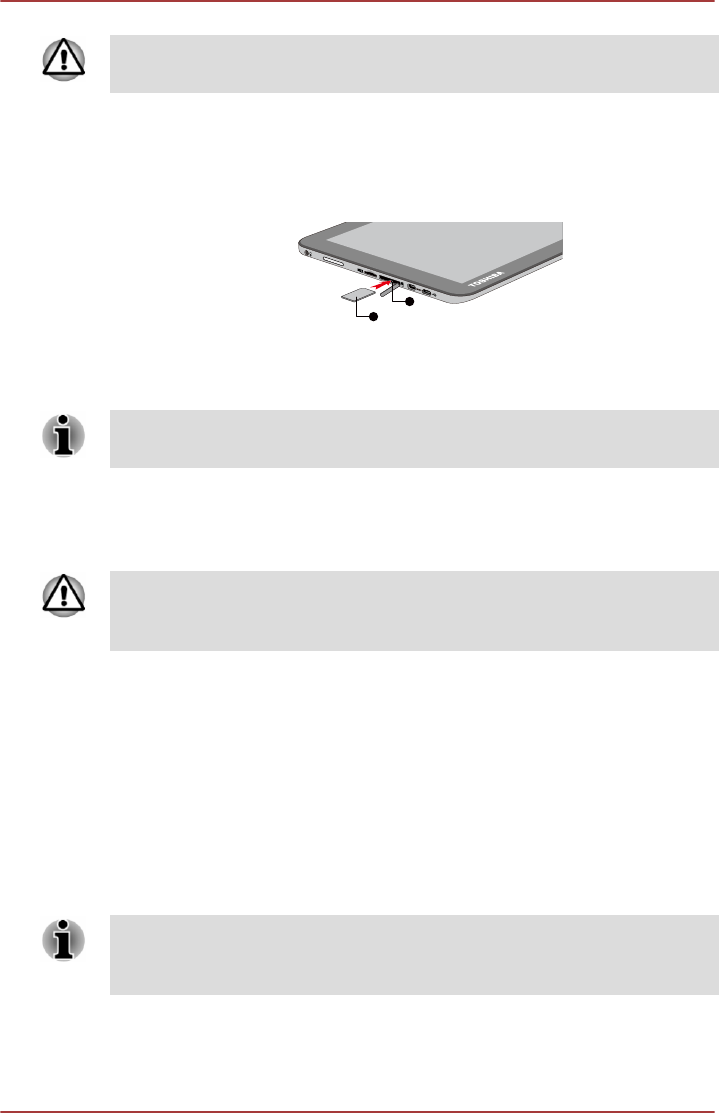
Do not carry out the following operations when the tablet is powered on,
otherwise the SIM card may be damaged.
1. Turn the SIM card so that the contacts (metal areas) are facing up.
2. Remove the slot cover and insert the SIM card into the SIM card slot
on the tablet and push it until you hear a click.
Figure 7-2 Inserting a SIM card
1
2
1. SIM card slot 2. SIM card
Now you can power on your tablet to use your provider’s mobile networks.
Please always keep a minimum of 1.5cm distance away from the antennas
area during operation.
Removing a SIM card
To remove a SIM card, follow the steps as detailed below:
Do not carry out the following operations when the tablet is powered on,
otherwise the SIM card may be damaged. Damage may also happen to the
tablet.
1. Remove the slot cover and push the SIM card until you hear a click to
partially release it.
2. Grasp it and pull it out of the slot.
USB device
This tablet is equipped with a Micro-USB port supporting USB host
function. This allows you to connect the following USB devices to the
tablet: USB flash drives, USB HDDs (only FAT file system), USB Hubs
powered by an AC adapter, game controllers and other USB accessories
for Android-powered devices. This port complies with USB 2.0 standard.
Support of HIDs (Keyboards and Mouse) connection will only be available
by the latest software. Please upgrade the software to the latest version
after your purchase of the tablet.
To connect a USB device, you must purchase a Micro A plug - A
receptacle cable. This item is available from your reseller or TOSHIBA
dealer.
User's Manual 7-4
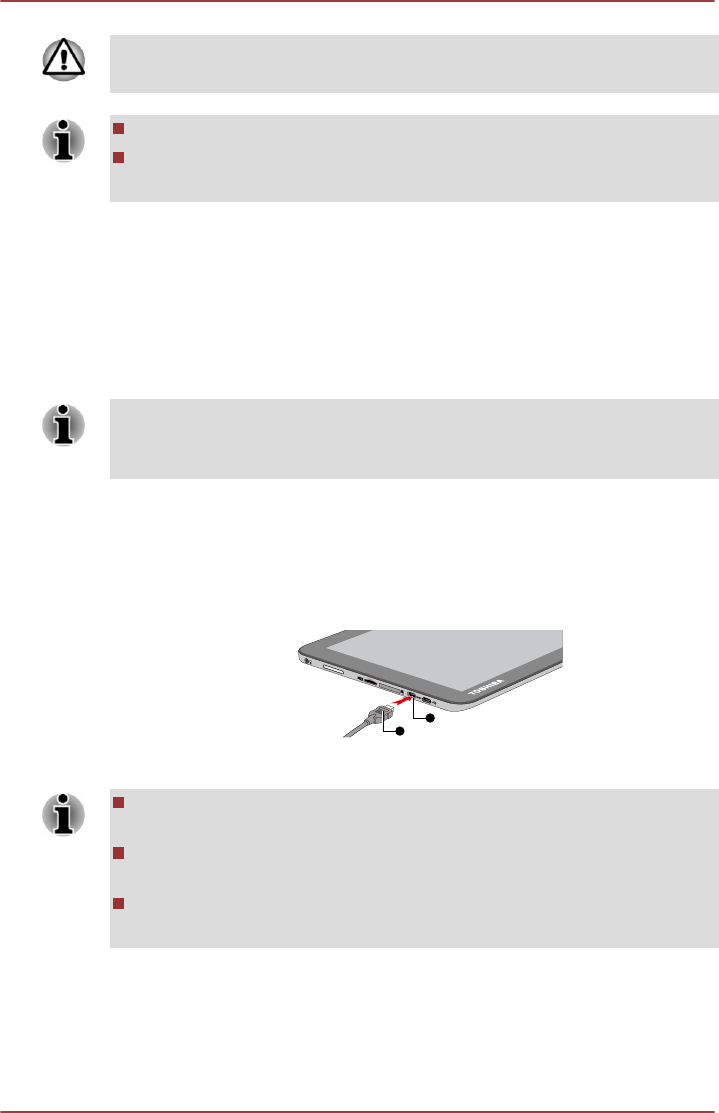
Make sure the connector is properly aligned with the socket. Do not try to
force the connection, doing so can damage the connecting pins.
This tablet does not support a printer.
As the port operation of all USB devices has not been confirmed,
some USB devices may not function properly.
HDMI device
The tablet is equipped with a Micro-HDMI port that can send video by
connecting with external devices. Your tablet supports 1080p and 720p
signal formats. The available format depends on the HDMI device that you
are connected to.
To connect external devices, follow the steps as detailed below:
As the port operation of all HDMI (High-Definition Multimedia Interface)
display devices have not been confirmed, some HDMI display devices may
not function properly.
1. Plug Type D connector of the HDMI cable into the Micro-HDMI port on
your tablet.
2. Plug the other end of the HDMI cable into the HDMI port of the HDMI
device.
Figure 7-3 Connecting an HDMI cable
1
2
1. Micro-HDMI port 2. Micro-HDMI (Type D) connector
Please do not plug/unplug an HDMI device when the tablet is in Sleep
Mode.
When you connect a television or external monitor to the HDMI port,
make sure the display output device is set to HDMI.
When you unplug the HDMI cable and re-plug it, please wait at least 5
seconds before you re-plug the HDMI cable.
Wireless display
Your tablet supports wireless display that is a function to allow the tablet to
be wirelessly connected to external displays that support Miracast™. With
User's Manual 7-5

wireless display, your tablet screen will appear on the external display
without connecting any cable.
Wireless display function is a new innovative function, and TOSHIBA
has not confirmed compatibility of your tablet with any and all display
devices. Contact Toshiba technical support provided in Chapter 8 for
more information.
If you should experience any loss of your wireless display connection,
immediately restart both your tablet and display device.
The wireless display function will vary depending on surrounding
electromagnetic environment. You may occasionally experience
wireless display connection failure, display glitches, or even lose your
wireless display connection.
Even when your tablet is in sleep mode, your wireless display
connection will not disconnect and you may incur significant and
unintentional battery drain. To avoid this, always disconnect from your
display device when you finished your using or watching display
device.
Turning wireless display on or off
1. Tap All Apps -> Settings -> Display -> Cast screen.
2. Tap the Menu icon ( ) to select Enable Wireless display.
Connecting your tablet with a wireless display
You can connect a display wirelessly by the following steps:
1. Make sure that the wireless display is turned on on your tablet.
Your tablet will scan for and display the names of all available displays
in range. If the display you want to connect with is not included in the
list, make it discoverable. See the documentation that came with your
display to learn how to make it discoverable by your tablet, and for
other instructions for connecting.
2. Tap on the name of the display in the list to connect it.
Wireless display options
Tap the icon ( ) , the following options are available for paired display
devices.
Tap Forget to disconnect and remove it from the paired list.
Type a new name and tap Done to rename the paired display.
Disconnecting your tablet with a wireless display
You can disconnect your tablet with a wireless display by any of the
following ways:
Tap on the name of the display in the list to disconnect it.
User's Manual 7-6

Tap on the Disconnect button icon ( ) in notification panel.
Optional TOSHIBA Accessories
To make your computer even more powerful and convenient to use, you
can add a number of options and accessories. For reference, the following
list details some of the items that are available from your reseller or
TOSHIBA dealer:
AC Adaptor If you frequently use your tablet at more than one
site, it may be convenient to purchase an
additional AC adaptor to be kept at each site.
User's Manual 7-7

Chapter 8
Troubleshooting
TOSHIBA have designed this tablet for durability, however, if problems
occur you are able to use the procedures detailed in this chapter to help
determine the cause.
You should become familiar with this chapter as knowing what might go
wrong can help prevent problems from occurring in the first place.
Problem-solving process
If you observe the following guidelines, resolving problems will be much
easier.
Stop immediately when you recognize a problem exists as taking
further action may result in data loss or damage, or you may destroy
valuable problem related information that can help solve the problem.
Observe what is happening - write down what the system is doing and
what actions you performed immediately before the problem occurred.
Make a screenshot of the current display.
Please also be aware that the questions and procedures described in this
chapter are meant only as a guide, they are not definitive problem solving
techniques. In reality many problems can be solved simply, but a few may
require help from TOSHIBA Support - if you find you need to consult
others, be prepared to describe the problem in as much detail as possible.
Preliminary checklist
You should always consider the simplest solution first - the items detailed
in this checklist shall provide easy fixes for issues which appear to be
serious problems.
Make sure you turn on all peripheral devices before you turn on the
tablet.
Before you attach an external device you should first turn the tablet
off, then when you turn the tablet back on again it will recognize the
new device.
Make sure all optional accessories are configured properly in the
tablet's setup program and that all required driver software has been
loaded (refer to the documentation included with the optional
accessories for further information on its installation and
configuration).
Check all cables to ensure they are correctly and firmly attached to the
tablet - loose cables can cause signal errors.
User's Manual 8-1

Inspect all connecting cables for loose wires and all connectors for
loose pins.
Always try to make detailed notes of your observations and keep them in a
permanent error log - this will help you to describe your problems to
TOSHIBA Support. In addition, if a problem recurs, the log you have made
will help to identify the problem faster.
Hardware and system checklist
This section discusses problems caused by your tablet’s hardware or
attached peripherals. Basic problems may occur in the following areas:
Internal display panel
Memory Media Card
Wireless LAN
Sound system
USB device
Bluetooth
Internal display panel
Apparent tablet's display panel problems may be related to the tablet's
setup and configuration.
Problem Procedure
Problems above
remain unresolved
or other problems
occur
You should initially refer to the documentation
supplied to you with the software to understand the
cause of the problems.
If you are still unable to resolve the problem,
contact your reseller, dealer or service provider.
Memory Media Card
Problem Procedure
Memory media card
error occurs
Unmount memory media card by tapping All Apps
-> Settings -> Device -> Storage and then insert
memory media card once again.
If the problem exist, remove the memory media
card from the tablet and then reinsert it in order to
ensure it is firmly connected.
If the problem persists, then you should refer to the
documentation supplied with your memory media
card for further information.
User's Manual 8-2
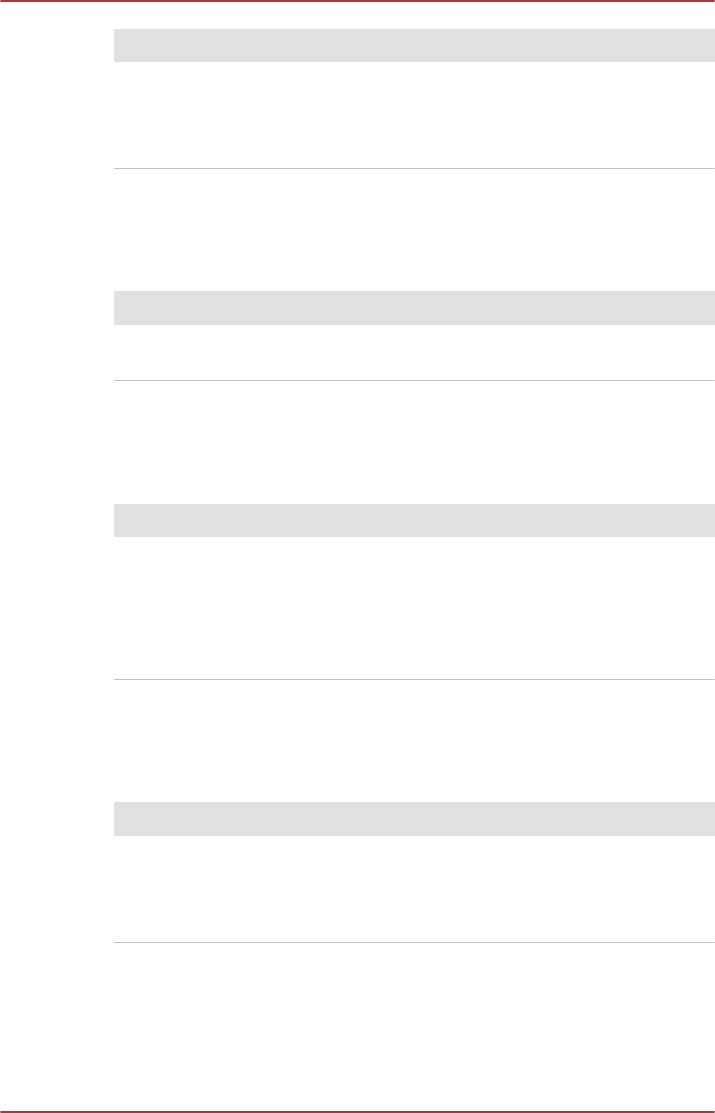
Problem Procedure
You cannot read a
file
Check to ensure the required file is actually on the
memory media card that is inserted into the tablet.
If you are still unable to resolve the problem,
contact TOSHIBA Support.
USB device
In addition to the information in this section, please also refer to the
documentation supplied with your USB device.
Problem Procedure
USB device does not
work
Remove the USB device from the convert cable
and reconnect it to ensure it is firmly attached.
Sound system
In addition to the information in this section, please also refer to the
documentation supplied with your audio device.
Problem Procedure
No sound is heard Adjust the volume.
Check the software volume settings.
Check to see if system sound is muted.
Check to make sure the headphone connection is
secure.
Wireless LAN
If the following procedures do not restore LAN access, consult your LAN
administrator.
Problem Procedure
Cannot access
Wireless LAN
Make sure the tablet's Wireless communication
function is on.
If problems persist, contact your LAN
administrator.
User's Manual 8-3
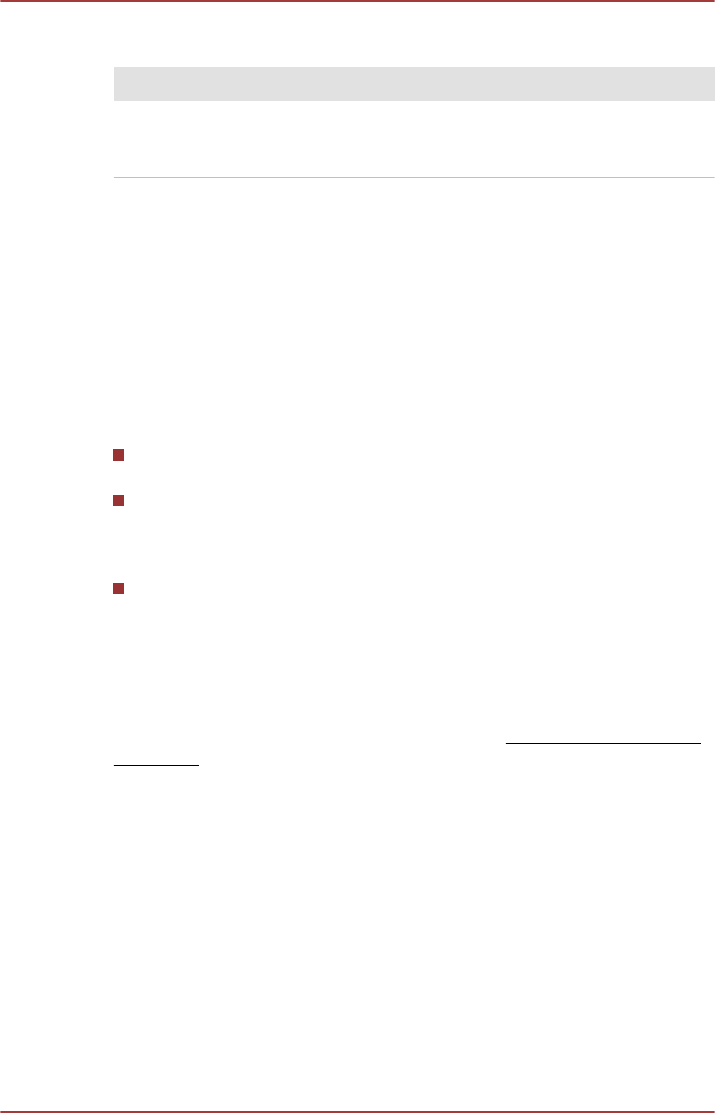
Bluetooth
Problem Procedure
Cannot access
Bluetooth device
Check to ensure the tablet's Bluetooth functionality
is set to on in All Apps -> Settings -> Wireless &
networks -> Bluetooth.
TOSHIBA Support
If you require any additional help using your tablet or if you are having
problems operating the tablet, you may need to contact TOSHIBA for
additional technical assistance.
Before you call
Some problems you experience may be related to software or the
operating system so it is important that you investigate other sources of
assistance first. Before contacting TOSHIBA, try the following:
Review troubleshooting sections in the documentation supplied with
your software and/or peripheral devices.
If a problem occurs when you are running software applications,
consult the software documentation for troubleshooting suggestions
and consider calling the software company's technical support
department for assistance.
Consult the reseller or dealer from where you purchased your tablet
and/or software - they are your best resource for current information
and support.
TOSHIBA technical support
If you are still unable to solve the problem and suspect that it is hardware
related, visit TOSHIBA technical support website http://www.toshiba.co.jp/
worldwide/.
User's Manual 8-4
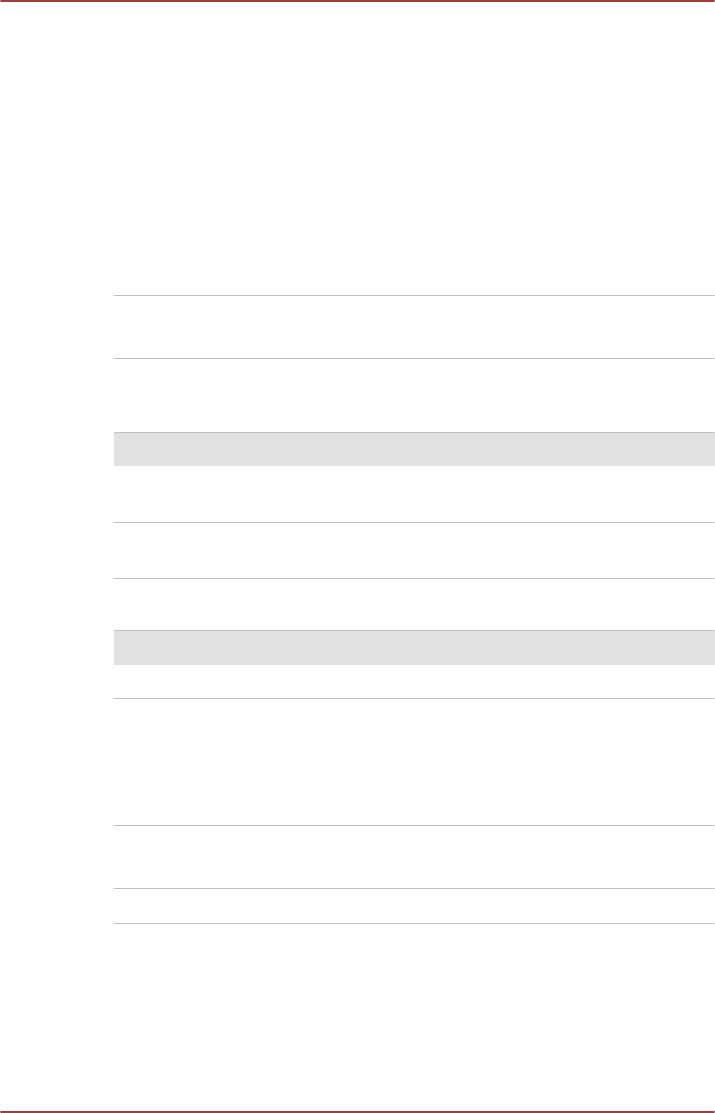
Chapter 9
Specifications
This chapter summarizes the tablet’s technical specifications.
Physical Dimensions
Size Approximately 259.4 (w) x 171.4 (d) x 10 (h) millimeters
(not including parts that extend beyond the main body).
Environmental Requirements
Conditions Ambient temperature Relative humidity
Operating 5°C (41°F) to 35°C
(95°F)
20% to 90%
(noncondensing)
Non-operating -20°C (-4°F) to 60°C
(140°F)
10% to 95%
(noncondensing)
Wet-bulb temperature 29°C maximum
Conditions Altitude (from sea level)
Operating 0 to 6,561 feet (2,000 meters)
Non-operating 0 to 40,000 feet (12,192
meters)
Power Requirements
AC adaptor 100-240V AC
50 Hz or 60 Hz (cycles per second)
Tablet 5V DC
User's Manual 9-1

Chapter 10
Information for Wireless Devices
Wireless Technology Interoperability
The Wireless LAN is compatible with other LAN systems Direct Sequence
Spread Spectrum (DSSS) /Orthogonal Frequency Division Multiplexing
(OFDM) radio technology, and is compliant to:
The IEEE 802.11 Standard on Wireless LANs (Revision a/b/g/n, b/g/n
or ac/a/b/g/n), as defined and approved by the Institute of Electrical
and Electronics Engineers.
The Wireless Fidelity (Wi-Fi®) certification as defined by the Wi-Fi
Alliance®.
TOSHIBA does not guarantee compatibility of this device with all
equipment using Bluetooth wireless technology.
This device is designed to be interoperable with any product with Bluetooth
wireless technology that is based on Frequency Hopping Spread Spectrum
(FHSS) radio technology, and is compliant to:
Bluetooth Specification (depending on the model you purchased), as
defined and approved by the Bluetooth Special Interest Group.
Logo certification with Bluetooth wireless technology as defined by the
Bluetooth Special interest Group.
CAUTION about Wireless Devices
The wireless devices have not completed verification of connection and
operation with all devices which are using the Wireless LAN or Bluetooth
radio technology.
Bluetooth and Wireless LAN devices operate within the same radio
frequency range and might interfere with one another. If you use Bluetooth
and Wireless LAN devices simultaneously, you might occasionally
experience a less than optimal network performance or even lose your
network connection.
If you experience any such problem, immediately turn off either one of your
Bluetooth or Wireless LAN.
If you have any questions about using Wireless LAN or Bluetooth Module,
visit http://www.pc.support.global.toshiba.com.
In Europe visit http://www.toshiba-europe.com/computers/tnt/bluetooth.htm
User's Manual 10-1

This Bluetooth product is not compatible with devices using Bluetooth
Version 1.0B specifications.
Wireless Devices and your health
Wireless products, like other radio devices, emit radio frequency
electromagnetic energy. The level of energy emitted by wireless products
however is far much less than the electromagnetic energy emitted by
wireless devices like for example mobile phones.
Because wireless products operate within the guidelines found in radio
frequency safety standards and recommendations, TOSHIBA believes
Wireless products is safe for use by consumers. These standards and
recommendations reflect the consensus of the scientific community and
result from deliberations of panels and committees of scientists who
continually review and interpret the extensive research literature.
In some situations or environments, the use of wireless products may be
restricted by the proprietor of the building or responsible representatives of
the organization. These situations may for example include:
Using the wireless products on board of airplanes, or
In any other environment where the risk of interference to other
devices or services is perceived or identified as harmful.
If you are uncertain of the policy that applies on the use of wireless devices
in a specific organization or environment (for example, airports), you are
encouraged to ask for authorization to use the wireless device prior to
turning on the equipment.
Radio Regulatory Information
The wireless device must be installed and used in strict accordance with
the manufacturer’s instructions as described in the user documentation that
comes with the product. This product complies with the following radio
frequency and safety standards.
Europe
Restrictions for Use of 2400.0-2483.5MHz Frequencies in
Europe
France: Outdoor use
limited to 10mW
e.i.r.p. within the
band
2454-2483.5MHz
Military Radiolocation use.
Refarming of the 2.4GHz band has
been ongoing in recent years to
allow current relaxed regulation Full
implementation planned in 2012.
User's Manual 10-2

Italy: - For private use, a general
authorization is required if WAS/
RLAN’s are used outside own
premises. For public use, a general
authorization is required.
Luxembourg: Implemented General authorization required for
network and service supply.
Norway: Implemented This subsection does not apply for
the geographical area within a
radius of 20 km from the centre of
Ny-Alesund.
Russian
Federation:
- Only for indoor applications.
Restrictions for Use of 5150-5350MHz Frequencies in Europe
Italy: - For private use, a general
authorization is required if WAS/
RLAN’s are used outside own
premises.
Luxembourg: Implemented General authorization required for
network and service supply.
Russian
Federation:
Limited e.i.r.p 100mW. Permitted to use
only for indoor applications, closed
industrial and warehouse areas,
and on board aircraft.
1. Permitted to use for local
networks of aircraft crew
service communications on
board aircraft in area of the
airport and at all stages of
flight.
2. Permitted to use for public
wireless access local networks
on board aircraft during a flight
at the altitude not less than
3000m.
Restrictions for Use of 5470-5725MHz Frequencies in Europe
Italy: - For private use, a general
authorization is required if WAS/
RLAN’s are used outside own
premises.
User's Manual 10-3

Luxembourg: Implemented General authorization required for
network and service supply
Russian
Federation:
Limited e.i.r.p 100mW. Permitted to use
only for indoor applications, closed
industrial and warehouse areas,
and on board aircraft.
1. Permitted to use for local
networks of aircraft crew
service communications on
board aircraft in area of the
airport and at all stages of
flight.
2. Permitted to use for public
wireless access local networks
on board aircraft during a flight
at the altitude not less than
3000m.
To remain in conformance with European spectrum usage laws for
Wireless LAN operation, the above 2.4GHz and 5GHz channel limitations
apply for outdoor usage. The user should use the wireless LAN utility to
check the current channel of operation. If operation is occurring outside of
the allowable frequencies for outdoor use, as listed above, the user must
contact the applicable national spectrum regulator to request a license for
outdoor operation.
Canada - Industry Canada (IC)
This device complies with RSS 210 of Industry Canada.
Operation is subject to the following two conditions: (1) this device may not
cause interference, and (2) this device must accept any interference,
including interference that may cause undesired operation of this device.
Ce dispositif est conforme à la norme CNR-210 d'Industrie Canada
applicable aux appareils radio exempts de licence. Son fonctionnement est
sujet aux deux conditions suivantes: (1) le dispositif ne doit pas produire de
brouillage préjudiciable, et (2) ce dispositif doit accepter tout brouillage
reçu, y compris un brouillage susceptible de provoquer un fonctionnement
indésirable.
Les dispositifs fonctionnant dans la bande 5.15-5.25GHz sont réservés
uniquement pour une utilisation à l'intérieur afin de réduire les risques de
brouillage préjudiciable aux systèmes de satellites mobiles utilisant les
mêmes canaux.
Les utilisateurs devraient aussi être avisés que les utilisateurs de radars de
haute puissance sont désignés utilisateurs principaux (c.-à-d., qu'ils ont la
priorité) pour les bandes 5.25-5.35GHz et 5.65-5.85GHz et que ces radars
User's Manual 10-4

pourraient causer du brouillage et/ou des dommages aux dispositifs LAN-
EL.
The term “IC” before the equipment certification number only signifies that
the Industry Canada technical specifications were met.
USA-Federal Communications Commission (FCC)
This equipment has been tested and found to comply with the limits for a
Class B digital device, pursuant to Part 15 of FCC Rules. These limits are
designed to provide reasonable protection against harmful interference in a
residential installation.
Refer to the FCC information section for the detailed information.
Caution: Exposure to Radio Frequency Radiation
The radiated output power of the wireless device is far below the FCC radio
frequency exposure limits. Nevertheless, the wireless device shall be used
in such a manner that the potential for human contact during normal
operation is minimized.
In the usual operating configuration, the distance between the antenna and
the user should not be less than 20 cm. Refer to the tablet user’s manual
for the details regarding antenna location.
The installer of this radio equipment must ensure that the antenna is
located or pointed in such a way that it does not emit RF field in excess of
Health Canada limits for the general population; consult Safety Code 6,
obtainable from Health Canada’s website www.hc-sc.gc.ca
Caution: Radio Frequency Interference Requirements
This device is restricted to indoor use due to its operation in the 5.15 to
5.25GHz frequency range.
High-power radars are allocated as primary users (that is, priority users) of
the bands 5.25 GHz to 5.35 GHz and 5.65 GHz to 5.85 GHz and that these
radars could cause interference and/or damage to LE-LAN devices.
Taiwan
Article 12 Without permission granted by the NCC, any
company, enterprise, or user is not allowed to
change frequency, enhance transmitting power or
alter original characteristic as well as performance
to an approved low power radio frequency devices.
User's Manual 10-5

Article 14 The low power radio-frequency devices shall not
influence aircraft security and interfere legal
communications;
If found, the user shall cease operating
immediately until no interference is achieved.
The said legal communications means radio
communications is operated in compliance with the
Telecommunications Act.
The low power radio-frequency devices must be
susceptible with the interference from legal
communications or ISM radio wave radiated
devices.
Using this equipment in Japan
In Japan, the frequency bandwidth of 2,400 MHz to 2,483.5 MHz for
second-generation low-power data communication systems such as this
equipment overlaps with that of mobile object identification systems
(premises radio station and specified low-power radio station).
1. Important notice
The frequency bandwidth of this equipment may operate within the same
range as industrial devices, scientific devices, medical devices, microwave
ovens, licensed radio stations and non-licensed specified low-power radio
stations for mobile object identification systems (RFID) used in factory
production lines (Other Radio Stations).
1. Before using this equipment, ensure that it does not interfere with any
of the equipment listed above.
2. If this equipment causes RF interference to other radio stations,
promptly change the frequency being used, change the location of
use, or turn off the source of emissions.
3. Contact an authorized TOSHIBA service provider if you have
problems with interference caused by this product to Other Radio
Stations.
2. Indication for Wireless LAN
The indication shown below appears on this equipment.
1. 2.4 : This equipment uses a frequency of 2.4GHz.
2. DS : This equipment uses DS-SS modulation.
3. OF : This equipment uses OFDM modulation.
4. 4 : The interference range of this equipment is less than 40m.
User's Manual 10-6
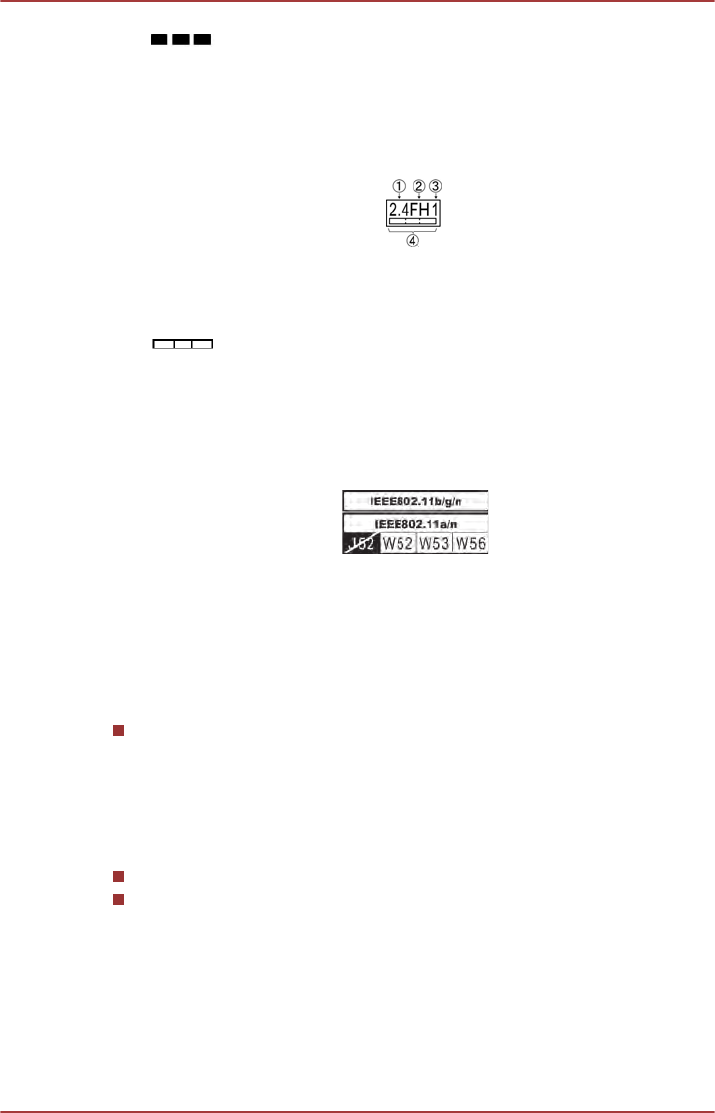
5. : This equipment uses a frequency bandwidth from 2,400MHz
to 2,483.5MHz. It is possible to avoid the band of mobile object
identification systems.
3. Indication for Bluetooth
The indication shown below appears on this equipment.
1. 2.4 : This equipment uses a frequency of 2.4 GHz.
2. FH : This equipment uses FH-SS modulation.
3. 1 : The interference range of this equipment is less than 10 m.
4. : This equipment uses a frequency bandwidth from 2,400
MHz to 2,483.5 MHz. It is impossible to avoid the band of mobile
object identification systems.
4. About the JEITA
5GHz Wireless LAN supports W52/W53/W56 Channel.
Device Authorization
This device obtains the Technical Regulation Conformity Certification and it
belongs to the device class of radio equipment of low-power data
communication system radio station stipulated in the Telecommunications
Business Law of Japan.
Realtek® RTL8723BS 802.11n Wireless LAN and bluetooth
The Name of the radio equipment: RTL8723BS
DSP Research, Inc.
Approval Number: D140012018
The following restrictions apply:
Do not disassemble or modify the device.
Do not install the embedded wireless module into other device.
Radio approvals for wireless devices
Approved Countries/Regions
This equipment is approved to the radio standard by the countries/regions
in the following table.
User's Manual 10-7
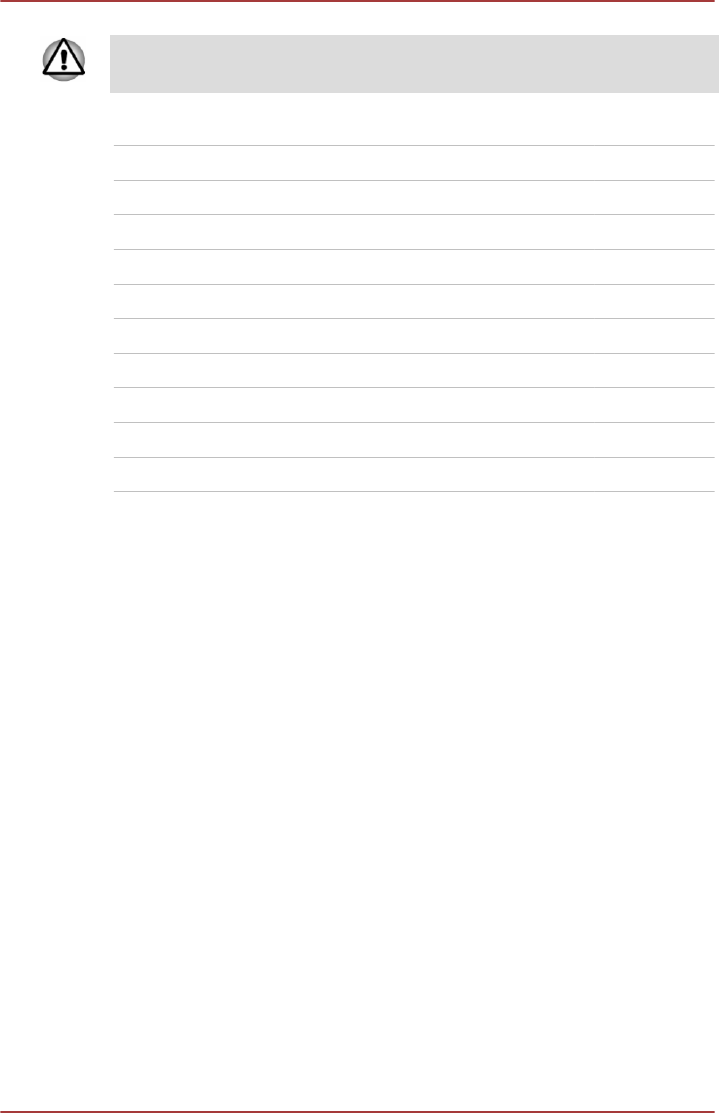
If you use this equipment in the countries/regions which are not listed in the
table blow, contact TOSHIBA Support.
As of October 2014
Austria Belgium Bulgaria Canada
Cyprus Czech Rep Denmark Estonia
Finland France Germany Greece
Hong Kong Hungary Iceland India
Indonesia Ireland Italy Japan
Korea Latvia Liechtenstein Lithuania
Luxemburg Malta Monaco Netherlands
Norway Philippines Poland Portugal
Romania Slovak Republic Slovenia Spain
Sweden Switzerland UK USA
User's Manual 10-8